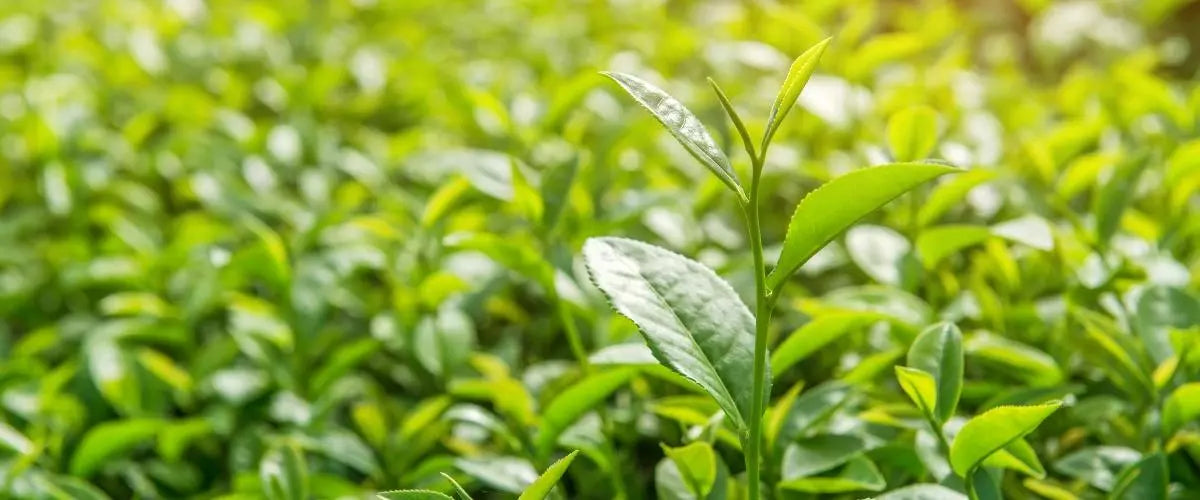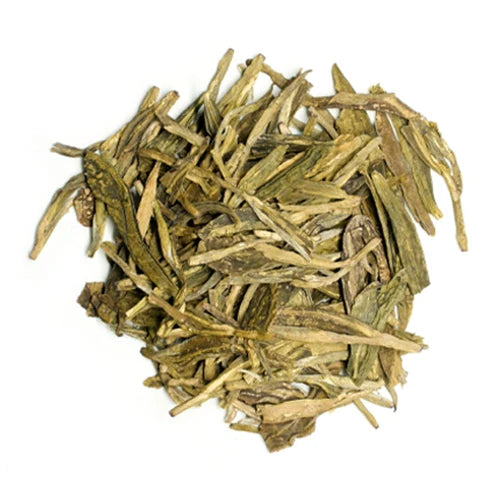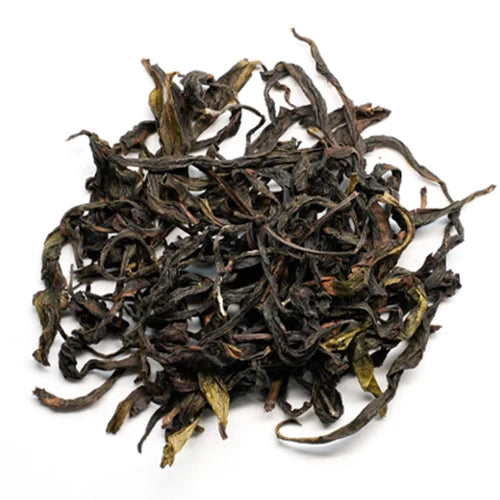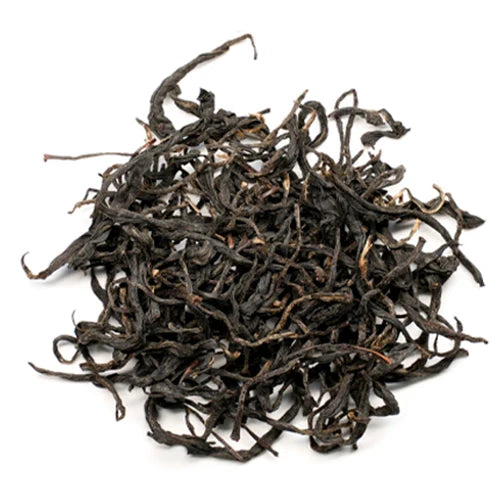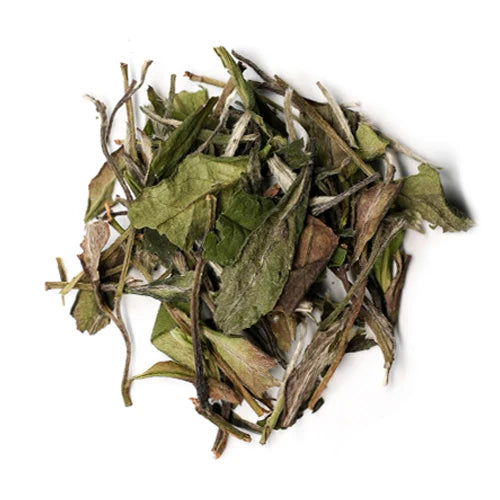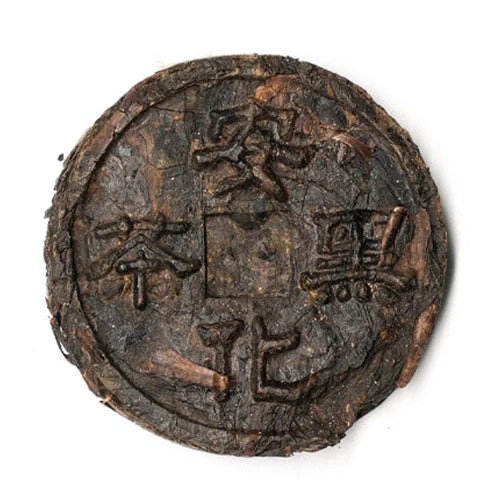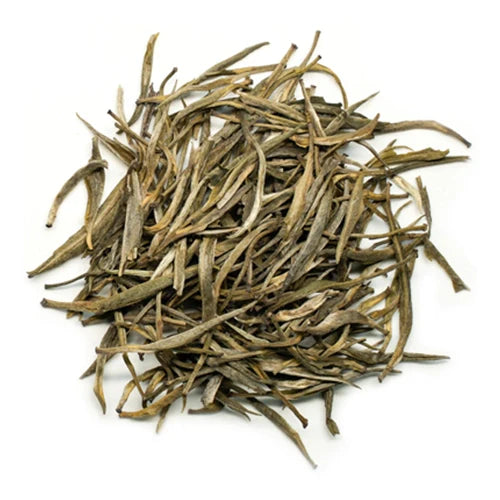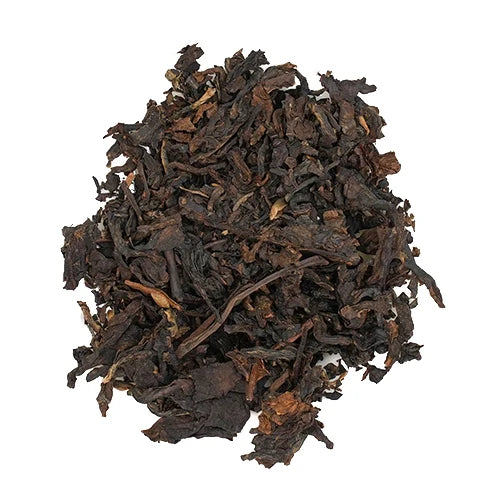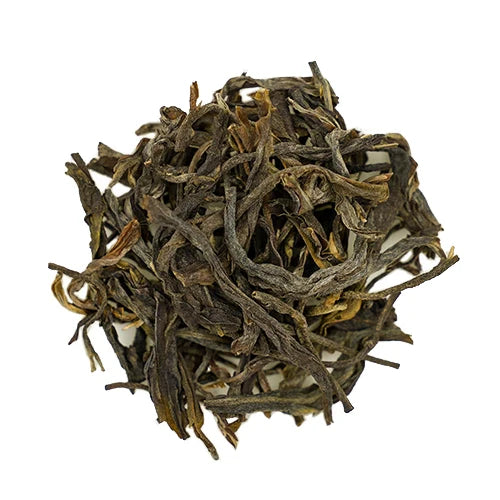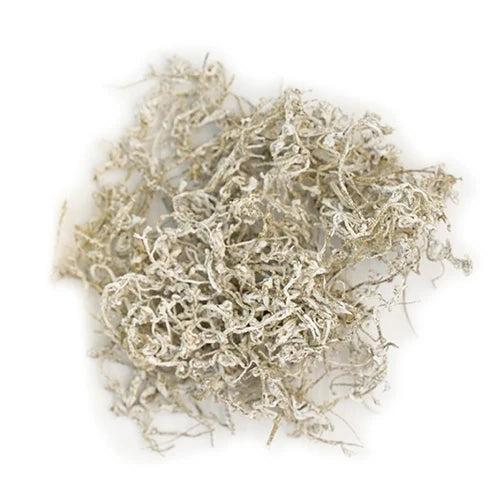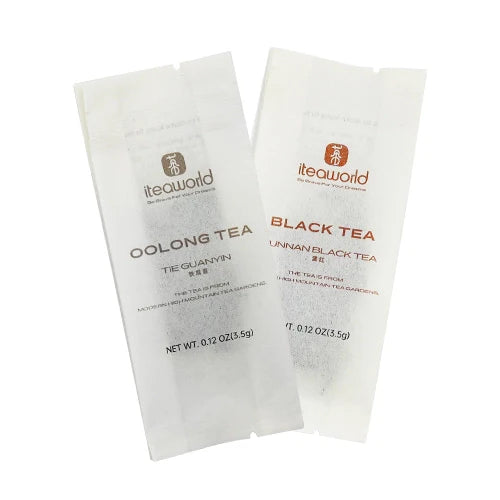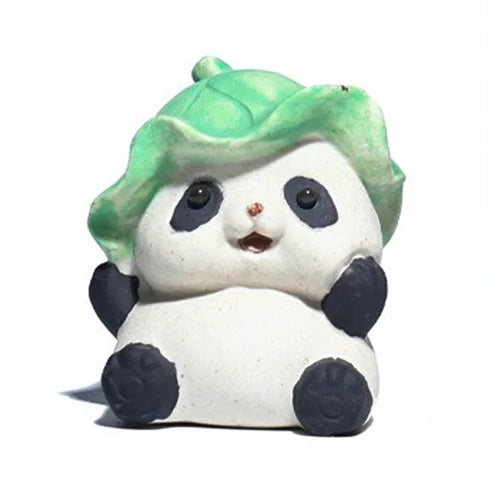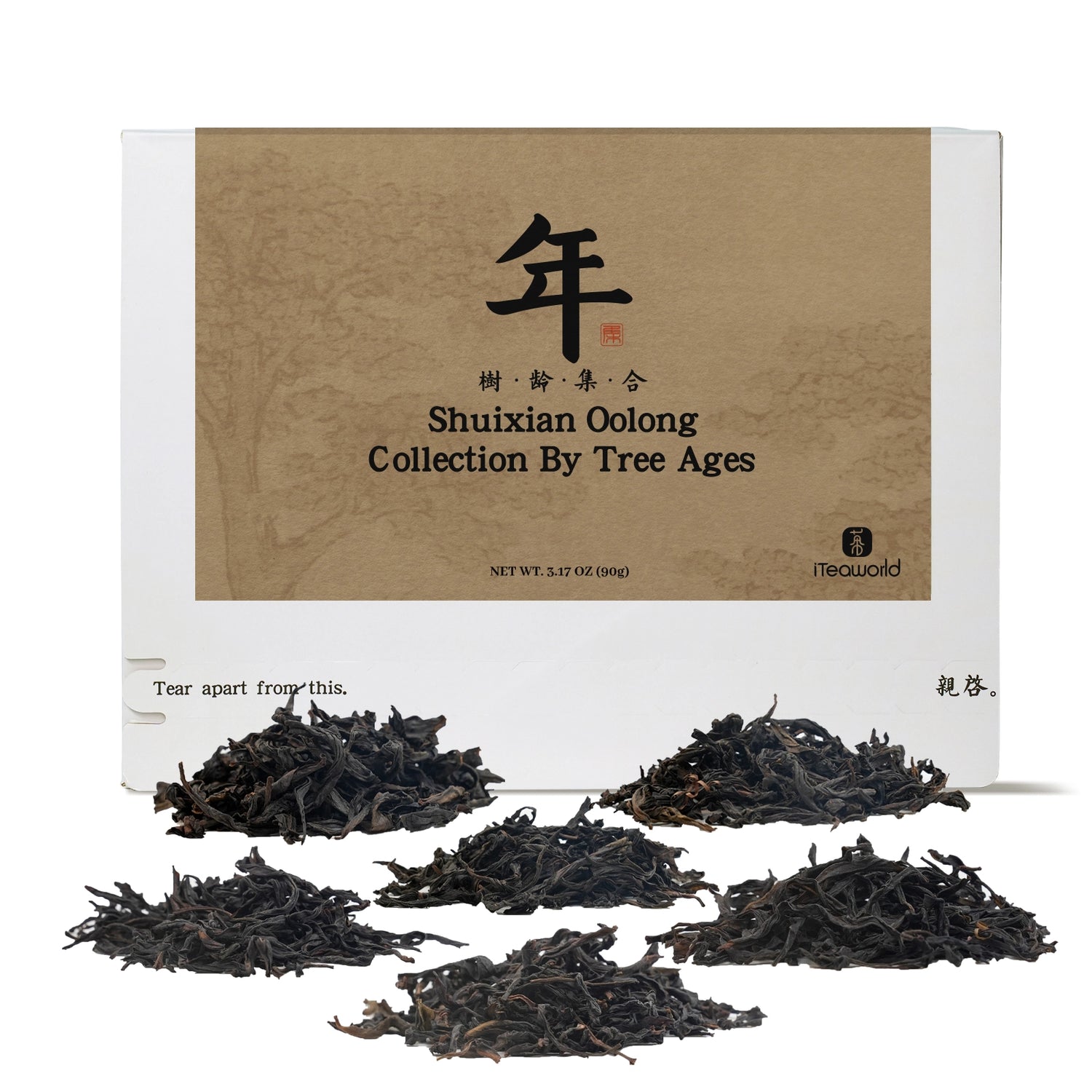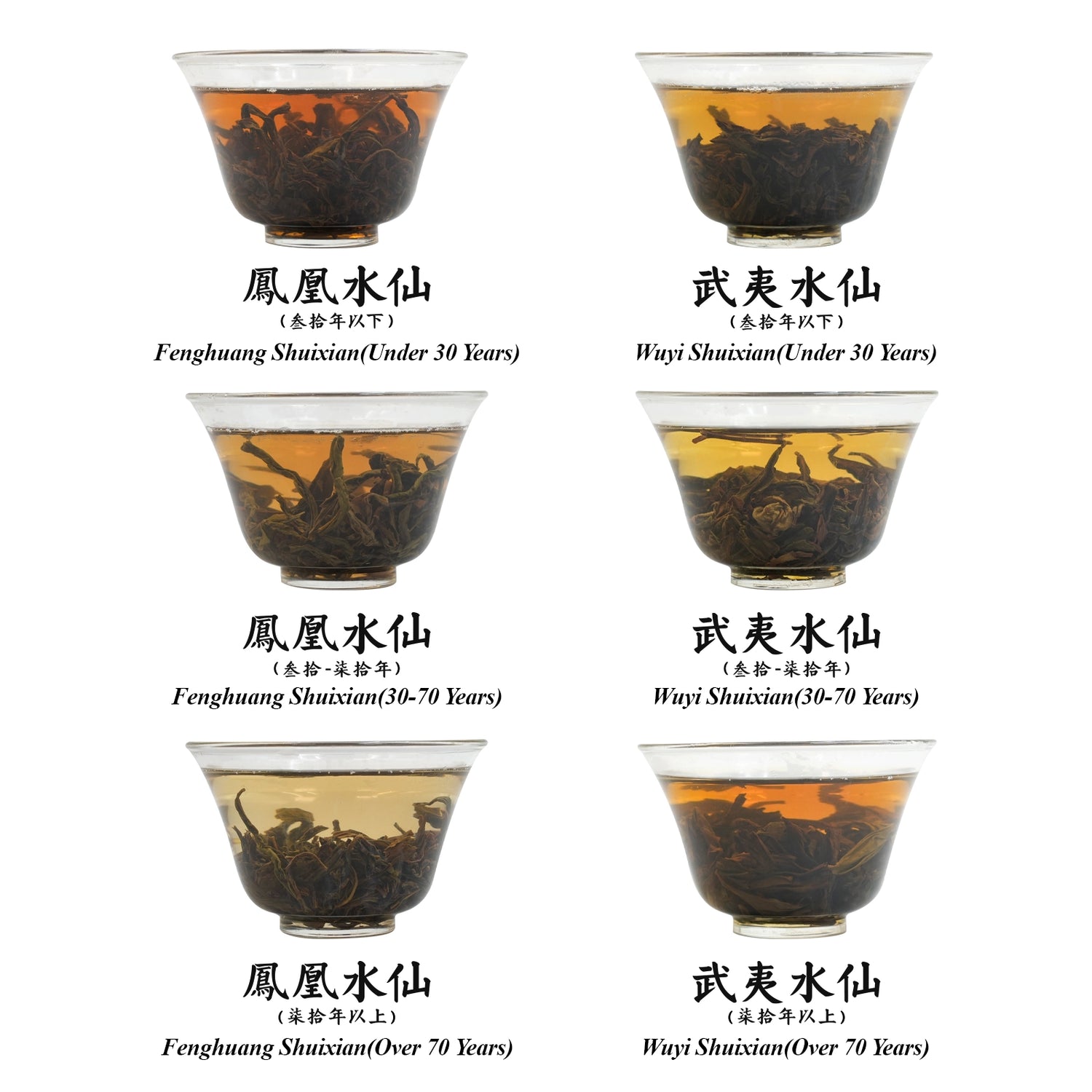Сортировать по:
12 продуктов
12 продуктов
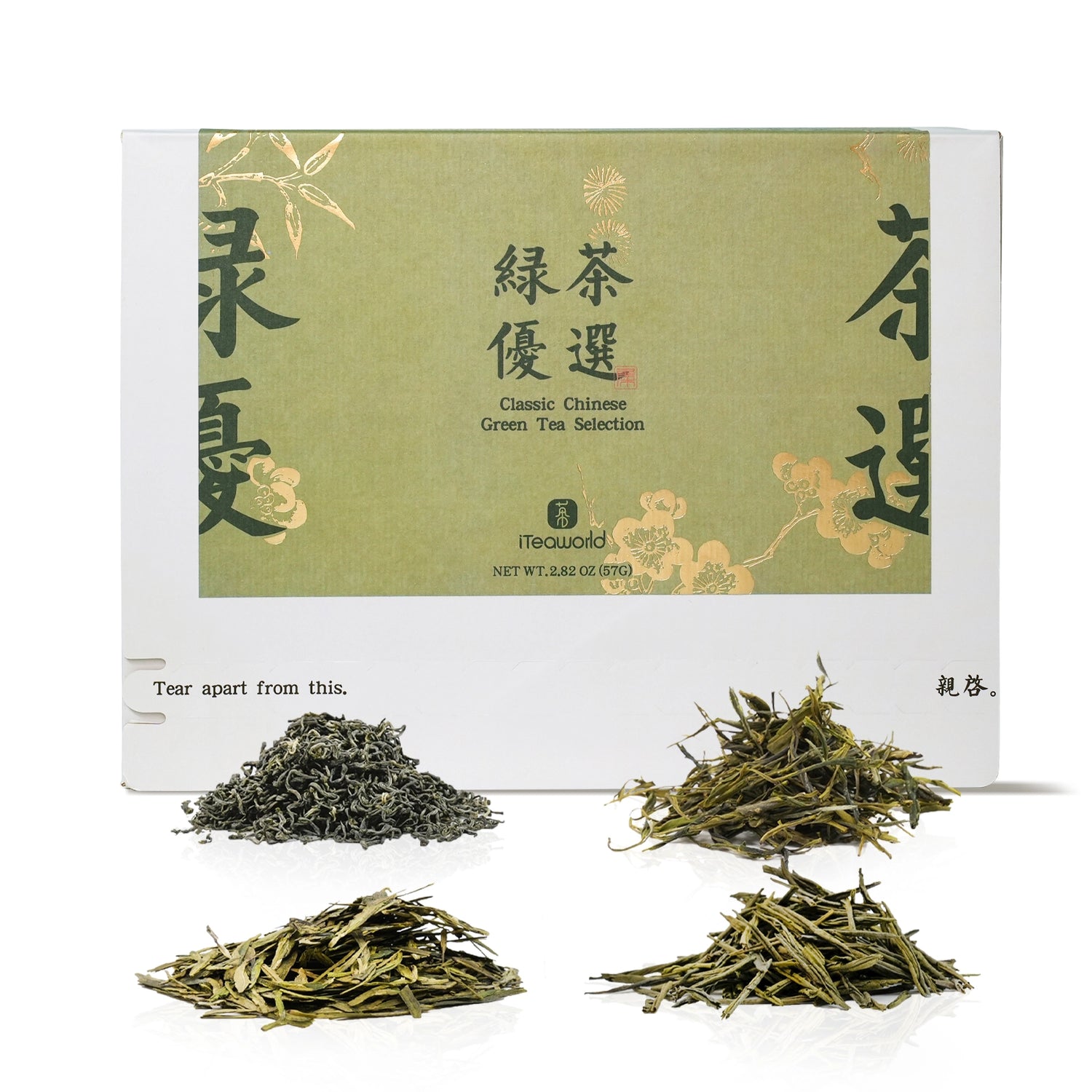


Пробник китайского зеленого чая – 4 сорта для начинающих 57 г
Пробник китайского зеленого чая – 4 сорта для начинающих 57 г
Кто-то спросил: «Я новичок в китайском зеленом чае и хочу попробовать несколько известных сортов, не жертвуя качеством». Эта коллекция создана именно для этого. Мы отобрали 4 лучших из 10 известных зеленых чаев Китая: Лунцзин, Билуочунь, Хуаншань Маофэн и Луань Гуапянь. Мы закупили их напрямую у аутентичных производителей в классических районах производства, предлагая отличное соотношение цены и качества. Кроме того, мы выбрали высокогорные чаи с групповых плантаций, размножаемых семенами, и созданные мастерами чая с более чем 20-летним опытом. Каждый чай — весенний урожай 2024 года. Вот краткое введение к каждому:
Луань Гуапянь: уникальный зеленый чай 15 г
Lu'an Guapian — это исторический китайский чай, который когда-то был данью уважения королевской семье. Этот драгоценный зеленый чай по-прежнему сохраняет свое уникальное традиционное мастерство и вкус. Наш изысканный Lu'an Guapian изготавливается вручную мастером с 30-летним опытом работы, используя листья с мелколистовых чайных растений в горах Ци, Луань, Аньхой, выращенных на высоте 600 метров. Собранные в конце весны, листья нежные, с богатым ароматом и освежающим вкусом. Чай конца весны более доступен, чем чай ранней весны, с более выраженным чайным вкусом и слегка ослабленным ароматом. Lu'an Guapian собирают, выбирая только второй лист из почки и два листа, отбрасывая стебель и нежные листья, сохраняя эссенцию чая, чтобы обеспечить чистоту и нежную свежесть чайного настоя.
Билуочунь: Премиальный зеленый чай из Китая 15 г
Biluochun — один из самых известных зеленых чаев Китая, известный своей высокотемпературной обжаркой и первоначальной обжаркой на сковороде с последующей медленной сушкой при низкой температуре. В отличие от обжарки на сковороде Лунцзин, сушеный зеленый чай имеет отчетливый бобовый вкус, но аромат жарки Biluochun не выражен, предлагая более освежающий вкус. Этот высококачественный Biluochun имеет легкий цветочный и фруктовый аромат, слегка сладкий без горечи и обильные пушистые волоски. Несмотря на свою высокую сортность и вкус, он доступен по цене, потому что производится из чайных растений в Сычуани, а не из настоящего Dongting Biluochun из Сучжоу, Чжэцзян.
Хуаншань Маофэн: восхитительный зеленый чай 12 г
Huangshan Maofeng представляет высокогорные зеленые чаи Китая, выращенные с 60-летних чайных деревьев в суглинистой почве на высоте 800 метров. Изготовленный опытными мастерами чая с использованием традиционных методов сушки, этот чай предлагает идеальный баланс качества и ценности. Он богат минералами и источает освежающий аромат зеленого чая с тонким ароматом орхидеи. Его сладкий и нежный вкус бесконечно запоминается, что делает его идеальным для ежедневного употребления, особенно для тех, кто предпочитает сладкий вкус без горечи. Собранные весной высокогорные листья добавляют ему уникальный сладкий вкус и мягкую текстуру.
Лунцзин: знаменитый зеленый чай 15 г
Мы стремимся предоставлять аутентичный чай Лунцзин, отличающийся от популярного низкосортного «машинно-резаного Лунцзин». Наш чай отбирается из традиционного сорта Лунцзин в Лишуе, Чжэцзян, и изготавливается полуручным способом мастерами Лунцзин с более чем 30-летним опытом, сочетая традиционные методы с современными удобствами. Мы выбираем сбор чая после Grain Rain и до начала лета, когда вкус похож на вкус чая до Grain Rain, но более доступен. Наш чай поступает из высокогорных садов (900-1000 метров), где климат и высота создают среду, похожую на Западное озеро, что гарантирует превосходное качество и ценность.
Наш чай Лунцзин — высокого качества, тщательно отобранный от одной почки и двух листьев до одной почки и трех листьев, предлагающий цельные листья в отличие от машинно-резанного чая с большим количеством стеблей и неполных листьев. Наша цель — предложить подлинное разнообразие и мастерство высококачественного чая Лунцзин по цене начального уровня, гарантируя, что каждая чашка источает чистый аромат и элегантный вкус традиционного Лунцзин


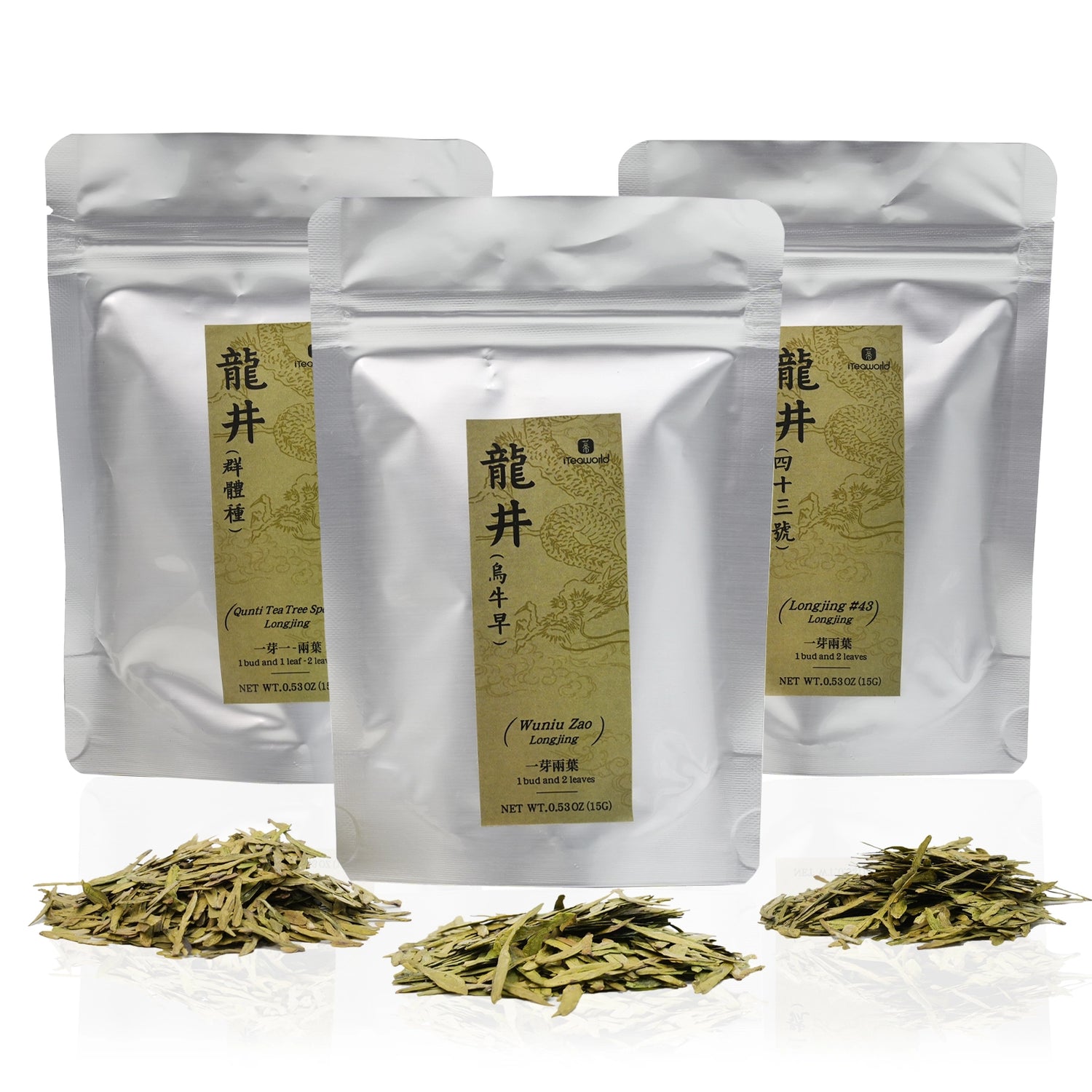
Сравнительный набор зеленого чая Лунцзин: 3 премиальных сорта 60 г
Сравнительный набор зеленого чая Лунцзин: 3 премиальных сорта 60 г
Введение:
Эта коллекция предлагает уникальную возможность исследовать тонкие различия во вкусе, аромате и текстуре, созданные тремя различными сортами чайного дерева, все из которых используют один и тот же сорт сбора: одну почку и два листа. Вы попробуете зеленый чай Лунцзин (Колодец Дракона), изготовленный из трех известных сортов чайного дерева: У Ню Цзао, Лунцзин № 43 и наследие Лунцзин Цюньти. Хотя сбор и обработка производятся одинаковым образом, каждый чай отражает уникальные характеристики своего дерева. Эта коллекция позволяет любителям чая открыть для себя свой любимый сорт этого классического зеленого чая.
Чистый вес чая: 45 г, в том числе:
Зеленый чай Лунцзин (сорт Униуцзао): 15 г
Зеленый чай Лунцзин (сорт Кунти): 15 г
Зеленый чай Лунцзин (сорт Лунцзин 43): 15 г
Происхождение трех видов чая Лунцзин: гора Тяньму, город Шэнчжоу, Шаосин, провинция Чжэцзян, Китай.
Основные преимущества:
Откройте для себя различные сорта: почувствуйте разницу между тремя видами чайных деревьев, которые формируют окончательный вкус и текстуру чая Лунцзин.
Образовательная дегустация: идеально подходит для любителей чая, желающих узнать, как различные сорта влияют на характер чая.
Подлинное мастерство: каждый чай изготавливается с использованием традиционных методов, позволяющих сохранить уникальные характеристики каждого сорта.
Наследие и инновации: от традиционного сорта Цюнти до более нового сорта Лунцзин № 43, эта коллекция предлагает сочетание традиций и современных методов выращивания.
Причины рекомендации:
Понимание различий сортов: эта коллекция предназначена для тех, кто хочет изучить, как сорта чайного дерева влияют на вкус и консистенцию чая Лунцзин.
Одинаковый сорт урожая, разные вкусы: вы можете сравнить чаи, приготовленные из одного и того же стандарта сбора (одна почка и два листа), но из разных сортов, что позволяет выявить тонкие, но существенные различия во вкусе.
Качество и профессионализм: эта коллекция, созданная опытными мастерами чая, подарит вам в чашку зеленый чай Лунцзин высочайшего качества.
Ценность для любителей чая: этот тщательно отобранный набор дает возможность продегустировать и сравнить чаи, которые не всегда легко найти на западных рынках.
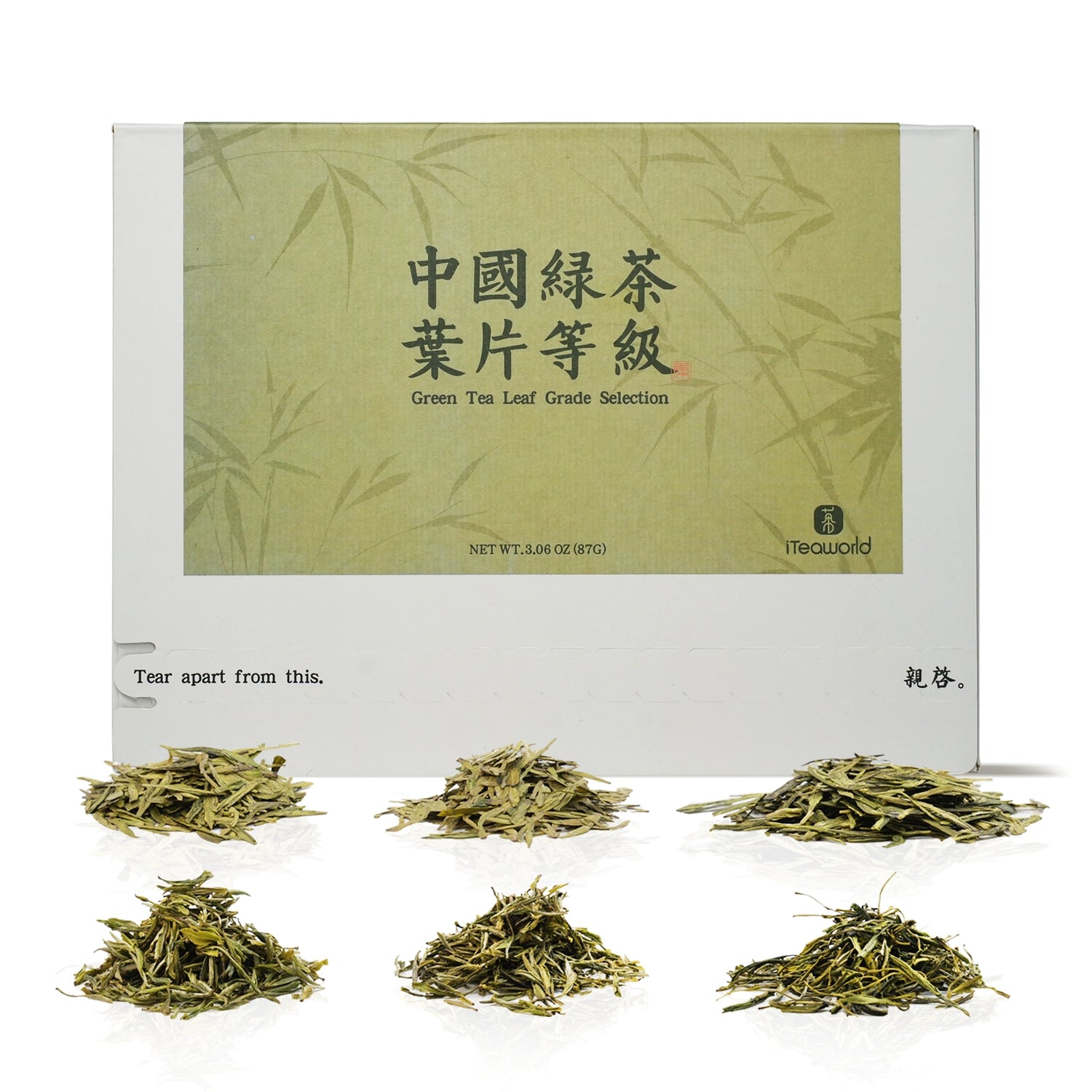
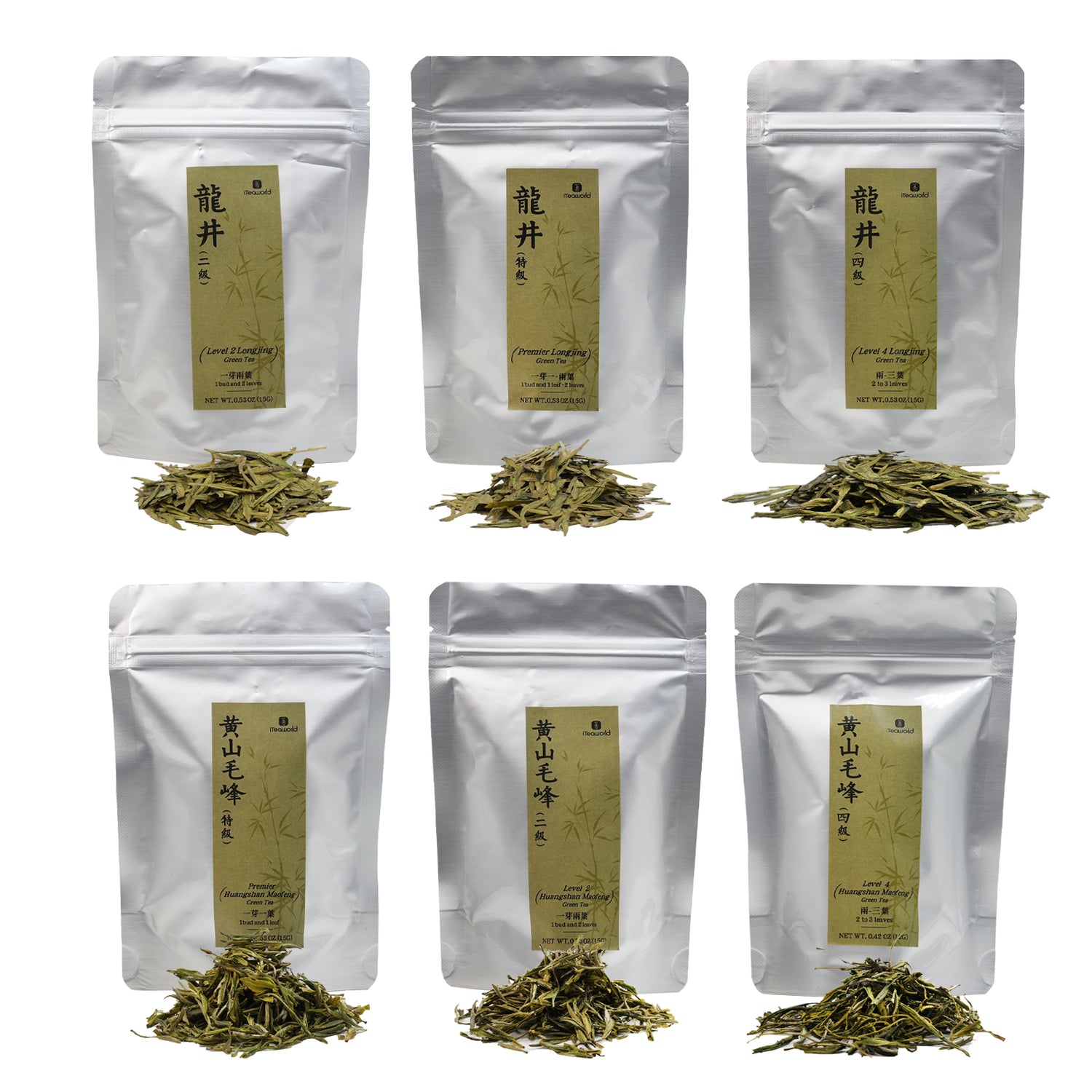
Сравнительный набор китайского зеленого чая: сорта Лунцзин и Хуаншань Маофэн 90 г
Сравнительный набор китайского зеленого чая: сорта Лунцзин и Хуаншань Маофэн 90 г
Представляем нашу коллекцию Green Tea Leaf Grade Collection, специально подобранную коллекцию, призванную помочь вам узнать, как сорт сбора листьев зеленого чая влияет на его вкус, аромат и общее впечатление от чаепития. В этот набор входят два известных китайских зеленых чая — Dragon Well (Longjing) и Huangshan Maofeng — оба из традиционных сортов реликвий. Единственное отличие? Сорт сбора листьев. Вы сможете попробовать три различных сорта:
Одна почка, один лист
Одна почка, два листа
Одна почка, три листа
Каждый чай собирается и обрабатывается вручную одним и тем же опытным мастером чая, чтобы обеспечить постоянство мастерства. Пробуя тонкие вариации этих разных сортов листьев, вы разовьете более глубокое понимание зеленого чая и найдете идеальный сорт для ваших личных предпочтений.
Причины рекомендации:
Изучайте и исследуйте – этот набор позволяет любителям чая понять прямое влияние сорта листа на вкус, текстуру и аромат чая.
Персонализированный опыт чаепития – попробовав разные сорта, потребители могут лучше выбрать идеальный чай на свой вкус.
Тщательно продуманное мастерство — все сорта чая изготавливаются одним и тем же мастером, поэтому единственное различие — это сорт сбора, что обеспечивает подлинное сравнение.
Высококачественные сорта — изготовленные из традиционных чайных деревьев, эти чаи предлагают насладиться настоящим китайским чаем, подчеркивая заботу и мастерство в производстве.
Этот набор идеально подходит для тех, кто интересуется нюансами зеленого чая или хочет усовершенствовать свои навыки выбора чая. Независимо от того, являетесь ли вы любителем чая или только начинаете, эта коллекция проведет вас через искусство оценки и дегустации зеленого чая.
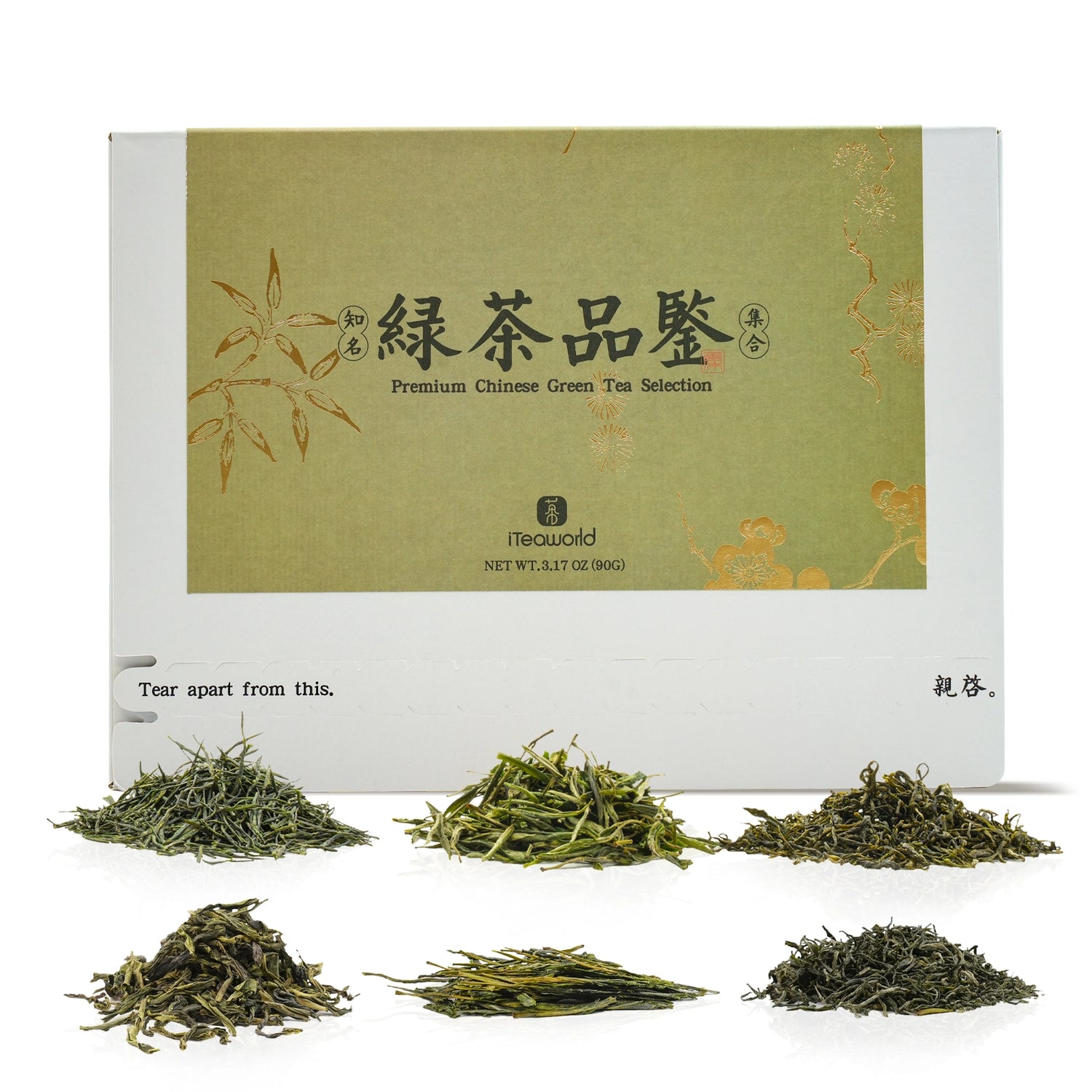
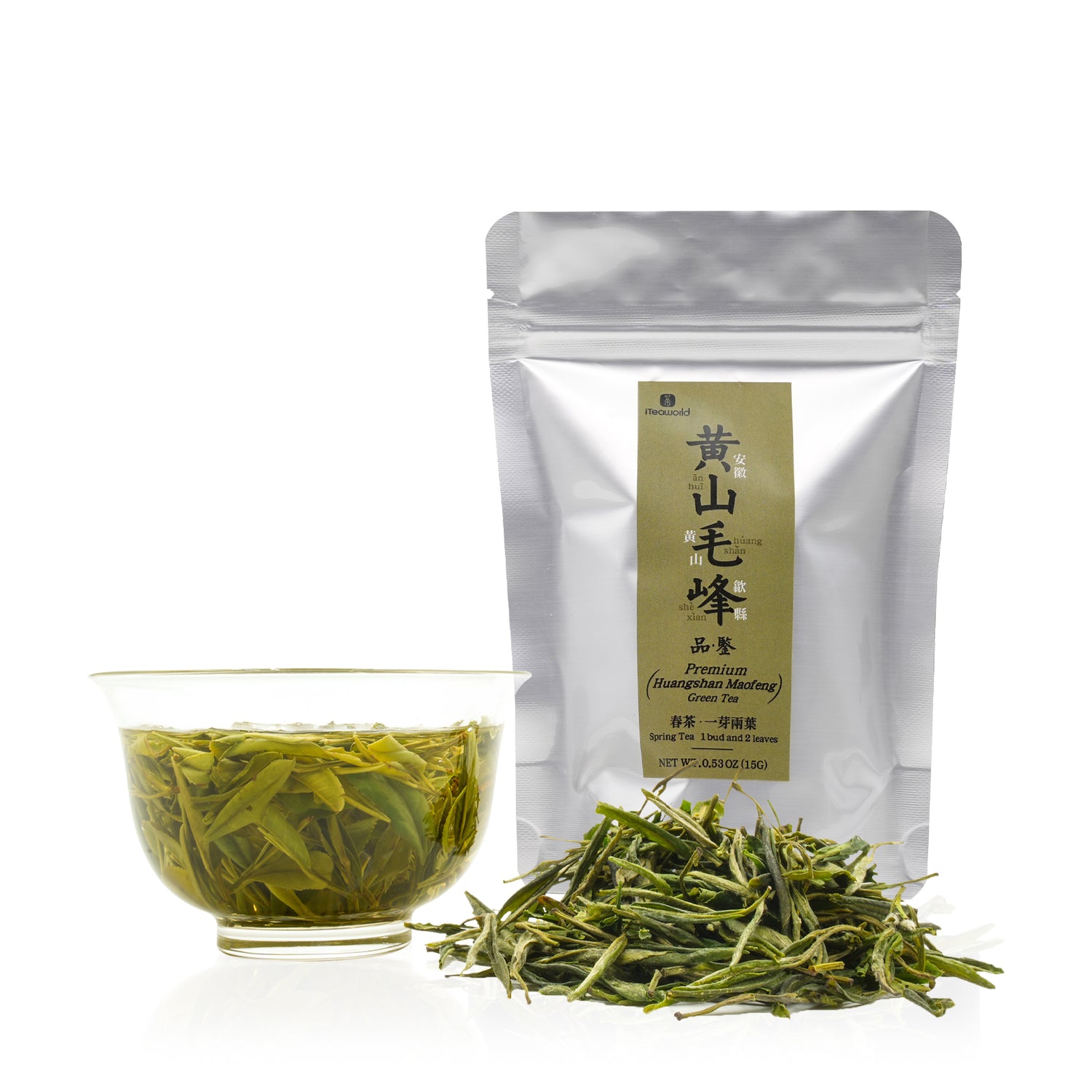
Сравнительный набор китайского зеленого чая: 6 редких сортов чая 90 г
Сравнительный набор китайского зеленого чая: 6 редких сортов чая 90 г
Вы, возможно, пробовали различные зеленые чаи, такие как Лунцзин, Чжуча и Жасминовый чай, но вы хотите изучить более качественные и недорогие китайские чаи. Чтобы гарантировать ценность, мы тщательно отобрали премиальные чаи из десяти самых известных сортов Китая, следуя этим ключевым принципам:
Сотрудничество с опытными мастерами чайного дела для обеспечения традиционного и искусного мастерства.
Выбираем листья высшего качества — одну почку и один или два листа — и вручную удаляем стебли и пыль, чтобы гарантировать чистоту.
Поставки чая напрямую от фермеров позволяют сохранить свежесть и качество, исключив посредников.
Мы гарантируем, что в нашем ассортименте будут представлены свежие весенние чаи урожая 2024 года, сохраняющие яркие вкусы и ароматы.
Отбор высококачественных листьев из подлинных сортов чая для гарантии уникального вкуса.
Баланс качества и доступности для удовлетворения потребностей потребителей.
Поставки из основных зон производства или близлежащих регионов для обеспечения постоянства терруара.
Избегая низкосортных равнинных чаев, отдавайте предпочтение тем, которые выращиваются на высоте более 600 метров, чтобы усилить сложность вкуса.
Масса нетто: 90 г, включая:
Премиум Билуочунь: 15 г
Премиум Энши Юлу: 15 г
Премиум Синьян Маоцзянь: 15 г
Премиум Луань Гуапянь: 15 г
Премиум Тайпин Хоукуй: 15 г
Премиум Хуаншань Маофэн: 15 г
Вот краткий обзор каждого чая:
Хуаншань Маофэн: Этот чай поступает из известного высокогорного региона, где чайные деревья, которым более 60 лет, растут на гравийной почве на высоте 800 метров. Признанный национальным нематериальным культурным наследием, Хуаншань Маофэн может похвастаться характерным ароматом с цветочными и сладкими нотками, производя чистый, яркий зеленовато-желтый чай, который дарит чистый опыт высокогорья.
Liu'an Guapian: Этот исторический королевский чай-подношение когда-то предназначался для императорской семьи. Наш премиальный Liu'an Guapian изготавливается вручную мастером с многолетним опытом, собранным с высокогорных чайных плантаций на высоте 600 метров. Собранные весной листья обеспечивают насыщенный аромат и освежающий вкус, что приводит к чистому, длительному послевкусию.
Taiping Houkui — знаменитый зеленый чай из района Тайпин в Хуаншане, провинция Аньхой, Китай. Он поступает из основного региона производства — деревни Цяошань в поселке Синьмин, известной своим прохладным, влажным климатом и плодородной почвой, идеально подходящей для выращивания чая. Наш премиальный Taiping Houkui производится из одной почки и трех листьев, обычно собираемых в сезон Grain Rain, с тонким белым пушком на листьях, указывающим на высокое качество. Чай выращивается из традиционного сорта «Ши Да Шу», размножаемого семенами, который созревает позже обычного. Из-за большой высоты в Хуаншане первый урожай также собирается в период Grain Rain. Мы работаем с мастером Ю Цзяньго, фермером-чайником с более чем 20-летним опытом, чтобы производить этот чай, который имеет свежий вкус и аромат.
Biluochun: как один из самых знаковых зеленых чаев в Китае, Biluochun славится своим уникальным цветочным и фруктовым ароматом. Наш премиальный Biluochun поставляется из Лияна, провинция Цзянсу, изготавливается с использованием традиционных методов и собирается в период до дождей, что обеспечивает свежий, нежный вкус с минимальной горечью. Этот высококачественный чай предлагает отличное соотношение цены и качества, его цена составляет от половины до трети от аналогичной продукции из основных регионов.
Xinyang Maojian: Лучший китайский зеленый чай, Xinyang Maojian поступает из основного производственного района в районе Шихэ, Синьян, расположенного в высокогорных горах на высоте 900 метров. Значительная разница температур днем и ночью создает уникальный элегантный аромат и свежий, насыщенный вкус. Наш весенний урожай 2024 года отличается листьями высочайшего качества с тонкими белыми волосками, указывающими на превосходное качество.
Enshi Yulu: Этот исторический пропаренный зеленый чай — единственный в Китае, который сохраняет этот традиционный метод изготовления. Наш Enshi Yulu поставляется из центральной области в Энши, провинция Хубэй, собирается вручную и изготавливается фермером-чайником с более чем 20-летним опытом. Используя высококачественные листья, этот чай свежий, насыщенный и слегка напоминает морские водоросли, а также богат натуральным селеном, известным своими иммуностимулирующими и антиоксидантными свойствами.
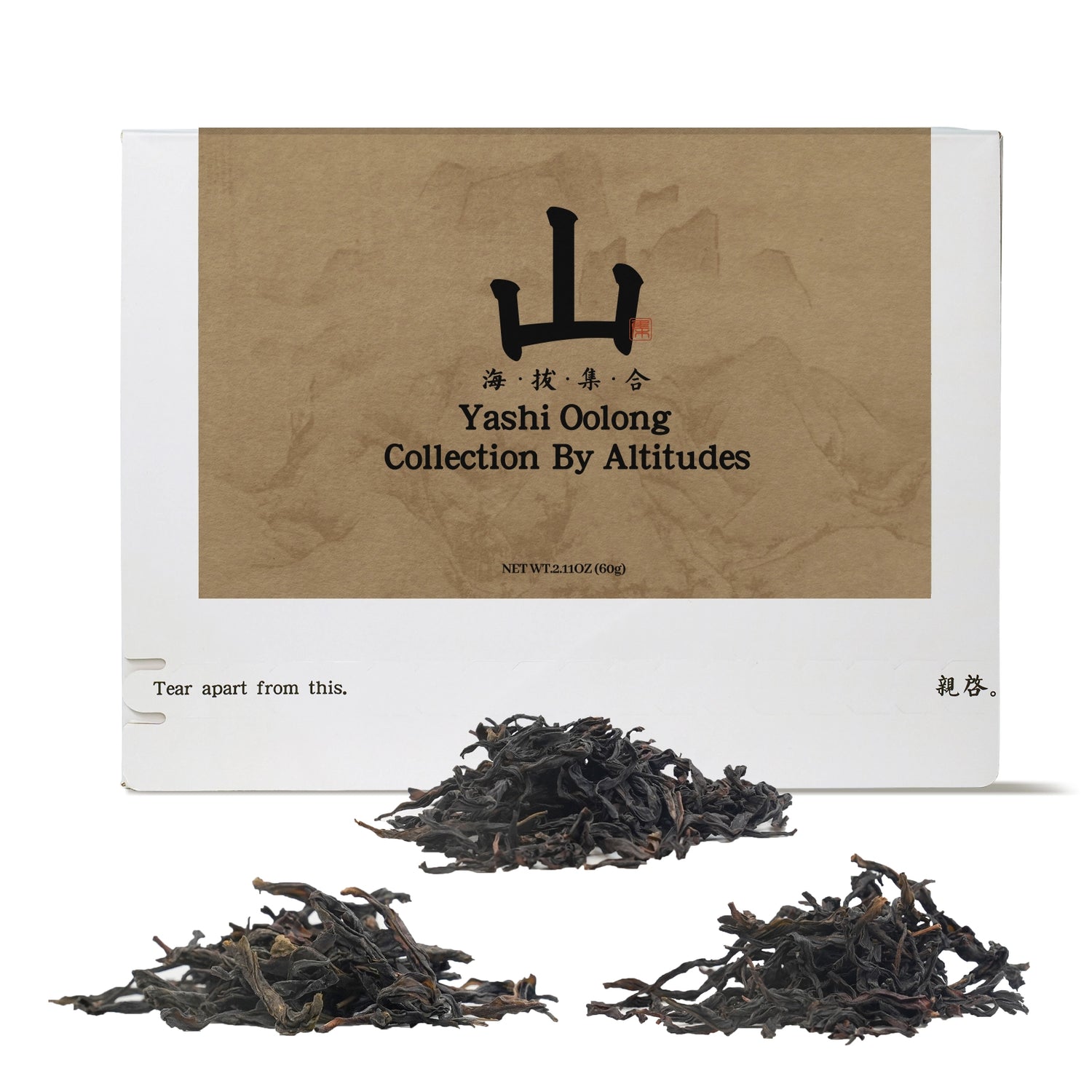
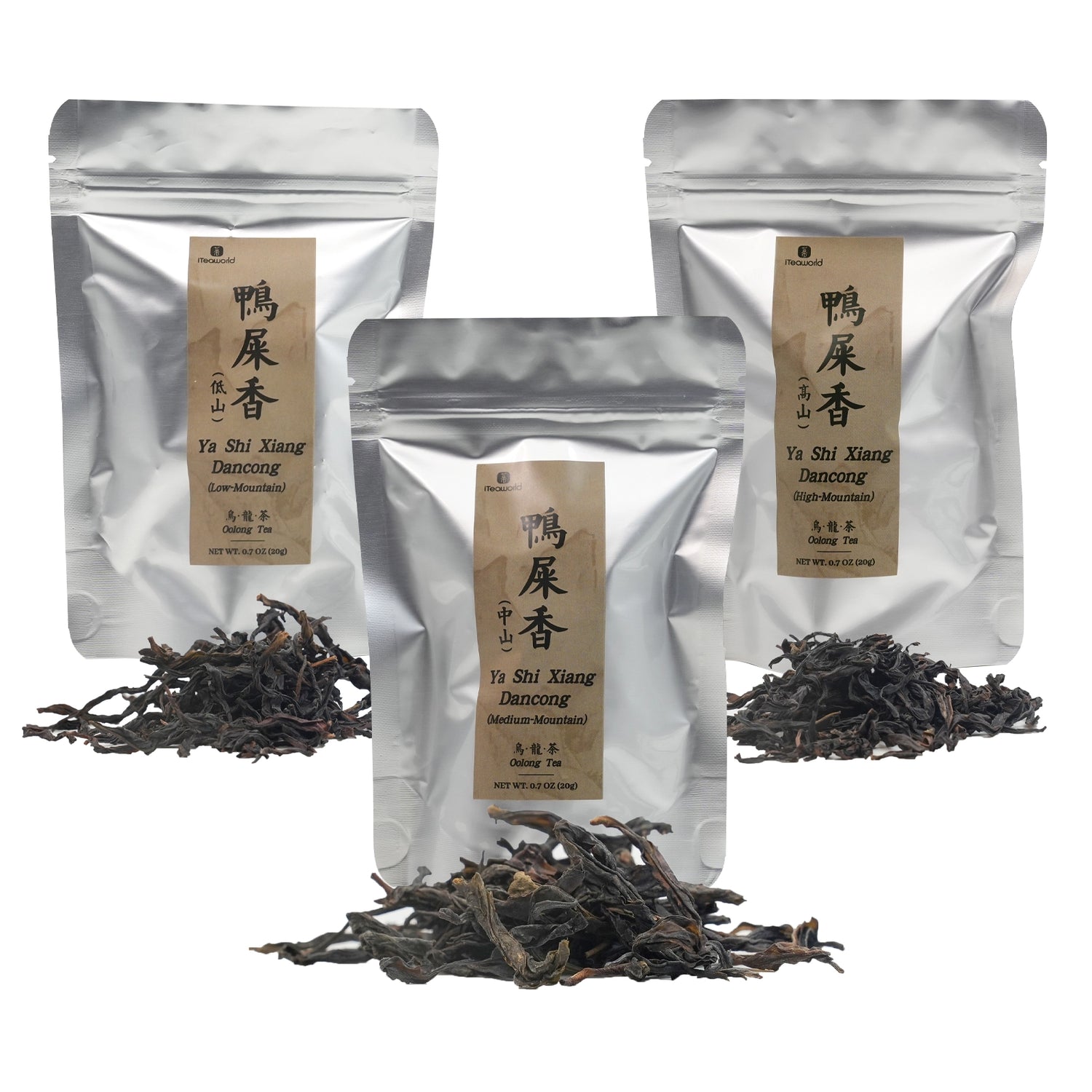
Сравнительный набор улунов Я Ши Сян: от низких до высоких гор 60 г
Сравнительный набор улунов Я Ши Сян: от низких до высоких гор 60 г
Стоит ли покупать высокогорный чай? Этот продукт может помочь вам принять решение
Высокогорный чай выращивают в регионах с большой разницей температур днем и ночью, более прохладными температурами и частой облачностью. Эти условия замедляют рост чая, сохраняя листья нежными и богатыми аминокислотами. В результате чай получается более сладким, свежим и ароматным. Высокогорные чаи идеально подходят для легких и средних уровней окисления и обжарки. Примерами высокогорных улунов являются Taiwan High Mountain Tea и Phoenix Dan Cong.
С другой стороны, чаи, произрастающие на низких высотах, обычно содержат больше полифенолов, но имеют более слабый аромат и меньшую выносливость при многократном заваривании.
В этом продукте представлены три чая Duck Shit Oolong, все они созданы одним и тем же мастером чая в городе Фэнхуан с похожими уровнями окисления и обжарки. Единственное различие — высота, на которой они были выращены, что позволяет легко сравнить, как высота влияет на вкус чая.
Включенные продукты:
- Я Ши Сян (Утиное дерьмо) Дан Цун Улун (Низкогорный) 20г
- Я Ши Сян (Утиное дерьмо) Дан Цун Улун (Средне-горный) 20г
- Я Ши Сян (Утиное дерьмо) Дан Цун Улун (Высокогорный) 20г
Источник:
- Нижний холм: деревня Хутоу, город Фэнхуан, город Чаочжоу, провинция Гуандун, Китай
- Средняя гора: водохранилище Фэнси, город Фэнхуан, город Чаочжоу, провинция Гуандун, Китай.
- Высокая гора: деревня Дунцзяо, город Фэнхуан, район Чаоань, город Чаочжоу, провинция Гуандун, Китай.
Мастер купажа : Линь Чжицян
Время обработки: июнь 2023 г.
Срок годности: 36 месяцев
Сорт чая: сорт Я Ши Сян
Высота:
- Низкогорье: 300-400 метров
- Среднегорный: 600 метров
- Высокогорье: 800-900 метров
Тип почвы: желтая почва
Степень окисления: 30-40%
Степень обжарки:
- Низкогорье: две обжарки, средне-слабый огонь (95-105°C / 203-221°F)
1-я обжарка: июнь-июль 2023 г., 2-я обжарка: после Праздника середины осени 2023 г. - Средне-горный: две обжарки, средне-слабый огонь (95-105°C / 203-221°F)
- Высокогорье: три обжарки, средне-слабый огонь (95-105 °C / 203-221 °F),1-я обжарка: июнь-июль 2022 г.,2-я обжарка: после Праздника середины осени 2022 г.,3-я обжарка: после китайского Нового года 2023 г.
Метод обжарки (уголь или электричество): брикетирование древесного угля
Рекомендации по завариванию:
Заваривание улуна в китайском стиле
Чайная утварь: гайвань или глиняный чайник.
Температура воды: 212°F (100°C)
Соотношение чая и воды: 1 г на 0,7 унции (20 мл)
Время заваривания: 10-15 сек (1-3 заваривания), добавить 5-10 сек после
Повторное заваривание: до 7 раз
Заваривание улуна в западном стиле
Чайная утварь: чайник, заварник или френч-пресс.
Температура воды: 190-200°F (88-93°C)
Соотношение чая и воды: 1 ч. л. (2-3 г) на 8 унций (240 мл)
Время заваривания: 3-5 минут
Повторное заваривание: до 3 раз, каждый раз добавляя по 1-2 минуты.
Возможно, вы не поклонник выдержанных чайных деревьев
И в пуэре, и в улуне возраст чайного дерева имеет значение. Как правило, старые деревья встречаются реже, что повышает их цену. Возраст деревьев имеет наибольшее значение в некоторых сортах улунов, таких как Шуйсянь (включая Феникс Шуйсянь, Уи Шуйсянь и Минбэй Шуйсянь).
Обычно молодые чайные деревья содержат больше аминокислот, но меньше полифенолов и минералов чая. Это приводит к тому, что чай получается более сладким и свежим, но с более легким, менее сложным вкусом. Такие чаи, как правило, имеют больше цветочных нот и лучше всего подходят для легкой ферментации и обжарки.
С другой стороны, старые чайные деревья, как правило, имеют более высокий уровень полифенолов чая, клетчатки, сахаров и минералов. Они не так ограничены методами обработки, и полученные чаи часто более насыщенные, с более выраженной сладостью, более длительным послевкусием и лучшей выносливостью для многократных завариваний.
В этом продукте представлены Phoenix Shui Xian и Wuyi Shui Xian из одного и того же источника, изготовленные с помощью схожих процессов, но из деревьев разного возраста. Это отличный способ сравнить, как возраст дерева влияет на вкус чая улун.
Включенные продукты:
- Фэнхуан Шуйсянь (до 30 лет)
- Фэнхуан Шуйсянь (30-70 лет)
- Фэнхуан Шуйсянь (более 70 лет)
- Уи Шуйсянь (до 30 лет)
- Уи Шуйсянь (30-70 лет)
- Уи Шуйсянь (более 70 лет)
Источник:
- Фэнхуан Шуйсянь (до 30 лет): деревня Шэньмин, город Фэнхуан, район Чаоань, город Чаочжоу, провинция Гуандун, Китай.
- Фэнхуан Шуйсянь (30-70 лет): деревня Дапин, город Фэнхуан, район Чаоань, город Чаочжоу, провинция Гуандун, Китай.
- Фэнхуан Шуйсянь (более 70 лет): Гезайвэй, деревня Удун, город Фэнхуан, район Чаоань, город Чаочжоу, провинция Гуандун, Китай.
- Уи Шуйсянь (до 30 лет): деревня Цзиншуй, город Синцунь, город Уишань, провинция Фуцзянь, Китай.
- Уи Шуйсянь (30–70 лет): деревня Даан, поселок Янчжуан, город Уишань, провинция Фуцзянь.
- Уи Шуйсянь (более 70 лет): деревня Тяньсинь, поселок Уи, город Уишань, провинция Фуцзянь.
Мастер купажа:
- Фэнхуан Шуйсянь: Линь Цзичжун, 林纪中
- Уи Шуйсянь: Чэнь Хуэй, 陈辉
Время обработки:
- Фэнхуан Шуйсянь: начало мая 2023 г.
- Уи Шуйсянь: май 2024 г.
Дата годности:
- 36 месяцев
Сорт чая:
- Сорт Фэнхуан Шуйсянь
- Сорт Уи Шуйсянь
Высота:
- Фэнхуан Шуйсянь (до 30 лет): 760 метров.
- Фэнхуан Шуйсянь (30-70 лет): 800-90 метров.
- Фэнхуан Шуйсянь (более 70 лет): 1150 метров.
- Уи Шуйсянь (до 30 лет): 400 метров.
- Уи Шуйсянь (30-70 лет): 800-900 метров.
- Уи Шуйсянь (более 70 лет): 500 метров.
Тип почвы:
- Фэнхуан Шуйсянь: желтая почва
- Уи Шуйсянь: гравийная почва
Уровень окисления:
- Средняя степень окисления (40-50%)
Степень обжарки:
- До 30 лет (вариант 1): три обжарки на среднем огне (110–115 °C / 230–239 °F)
- 30–70 лет (вариант 1): три обжарки на средне-сильном огне (110–115 °C / 230–239 °F)
- Более 70 лет (вариант 1): три обжарки на среднем огне (110–115 °C / 230–239 °F)
- До 30 лет (вариант 2): две обжарки на сильном огне (110–115 °C / 230–239 °F)
- 30–70 лет (вариант 2): три обжарки, слабый огонь (95–105 °C / 203–221 °F)
- Более 70 лет (вариант 2): слабый огонь, 95–105 °C (203–221 °F)
- (Слабый огонь ~ 80°C, Средний огонь ~ 100°C, Сильный огонь ~ 120°C)
Метод обжарки (уголь или электричество):
- брикетирование древесного угля
Рекомендации по завариванию:
Заваривание улуна в китайском стиле
Чайная утварь: гайвань или глиняный чайник.
Температура воды: 212°F (100°C)
Соотношение чая и воды: 1 г на 0,7 унции (20 мл)
Время заваривания: 10-15 сек (1-3 заваривания), добавить 5-10 сек после
Повторное заваривание: до 7 раз
Заваривание улуна в западном стиле
Чайная утварь: чайник, заварник или френч-пресс.
Температура воды: 100°C (212°F)
Соотношение чая и воды: 1 ч. л. (2-3 г) на 8 унций (240 мл)
Время настаивания: 3 минуты
Повторное заваривание: 3 раза, каждый раз добавляя по 1 минуте.
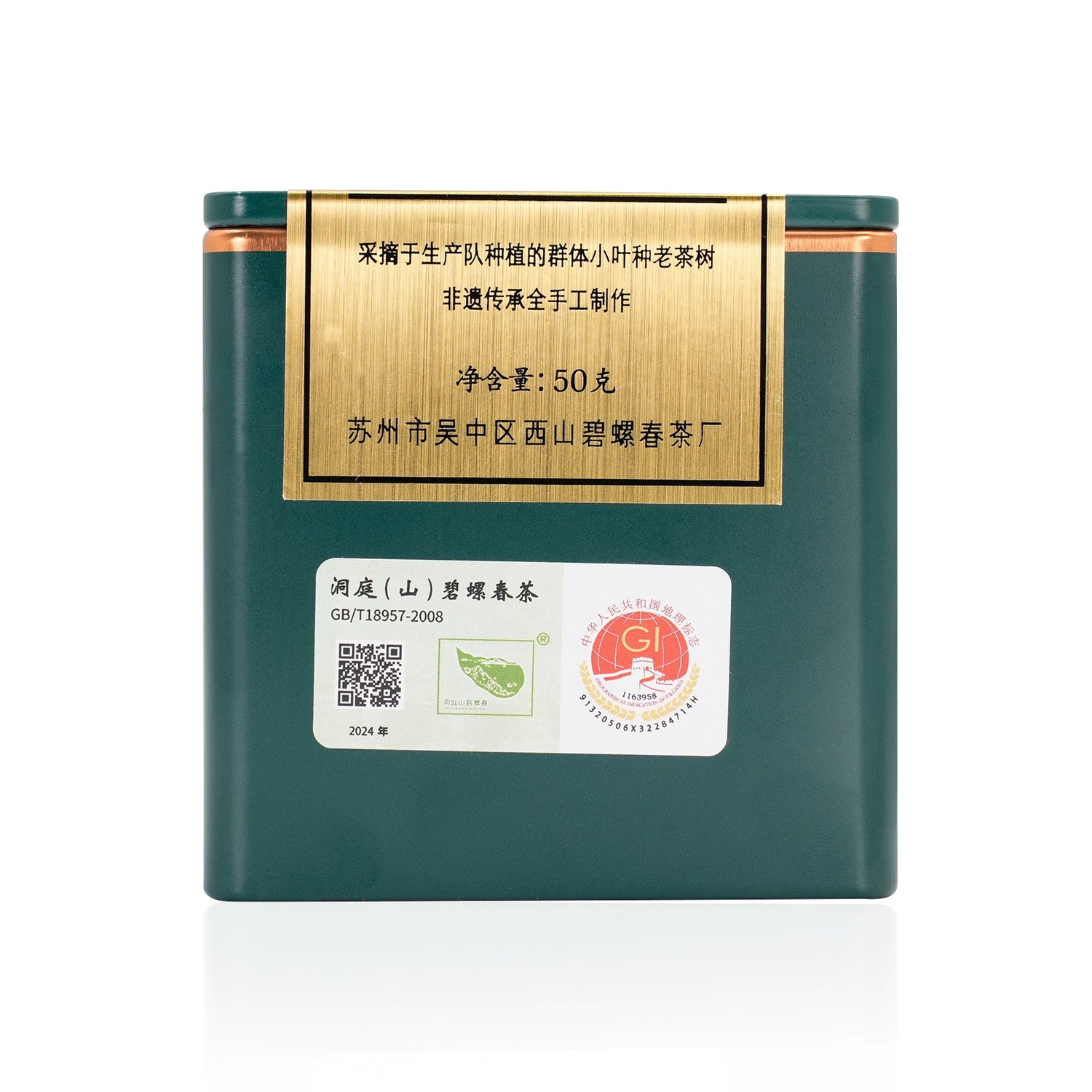
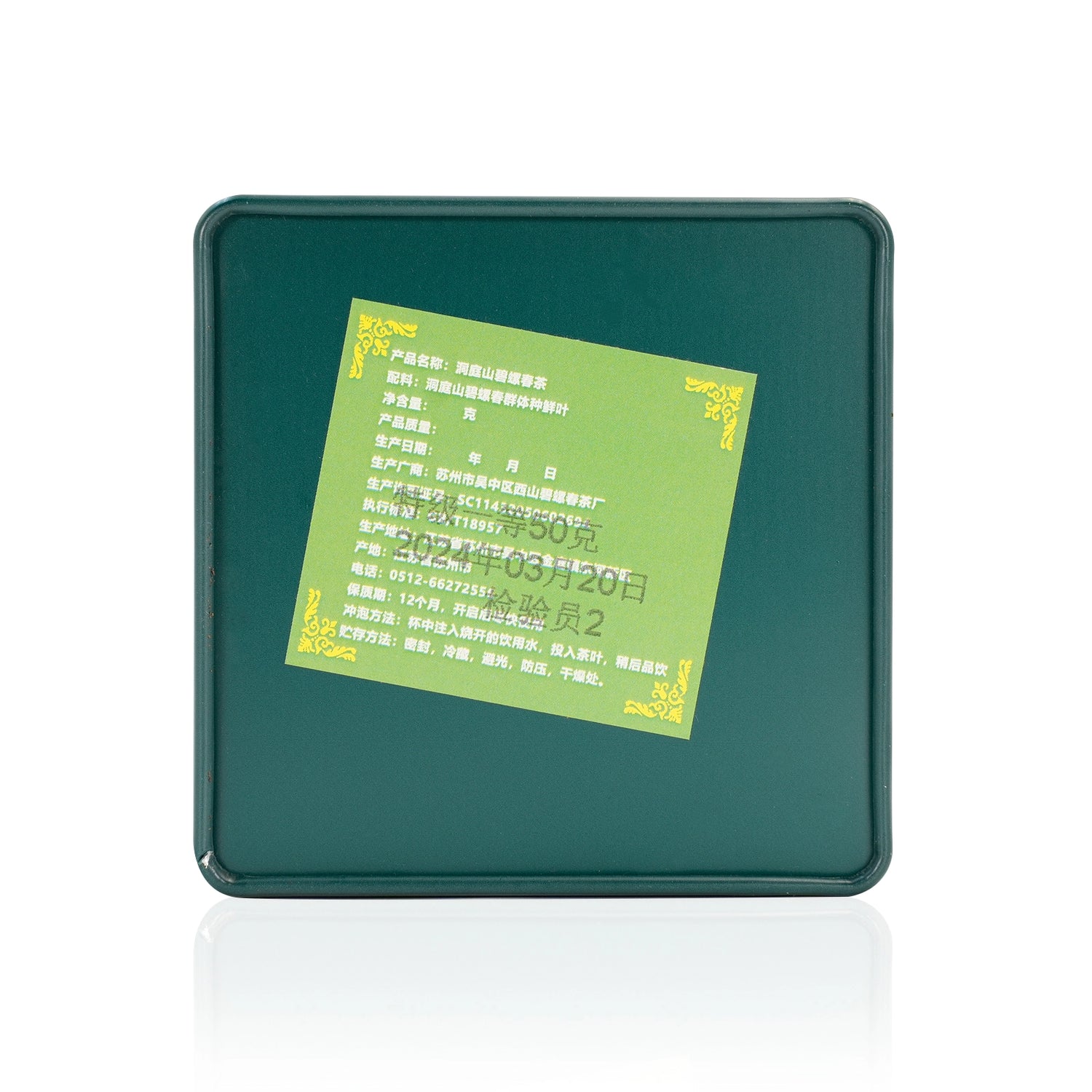
Сравнительный набор зеленого чая Biluochun: 5 сортов
Сравнительный набор зеленого чая Biluochun: 5 сортов
Почему мы сделали этот чай:
Biluochun — один из самых известных зеленых чаев Китая, который ценится любителями чая во всем мире за его уникальный вкус и аромат. Однако многие люди часто путаются при выборе Biluochun: более высокий сорт больше подходит или более низкого достаточно? Чтобы помочь вам лучше понять это, мы представляем этот набор общепризнанных учебных образцов Biluochun.
Введение в продукт:
Эта серия сортов Biluochun включает пять сортов: Special Grade One, Grade One, Special Grade Two, Grade Two и Grade Three. Каждый чай сертифицирован Китайской чайной ассоциацией и является общепризнанным учебным образцом сорта Biluochun. Пробуя Biluochun разных сортов, вы сможете систематически понять их характеристики и вкусовые различия, таким образом найдя чай, который лучше всего соответствует вашему вкусу и потребностям. Кроме того, эта серия продуктов поставляется с чайной фабрики Biluochun в Западной горе, районе Учжун, городе Сучжоу. Чайные листья растут в среде с различными сезонами и подходящим климатом, что гарантирует их подлинность по происхождению, разнообразию и вкусу, а также высокое качество и уникальный натуральный цветочный и фруктовый аромат.
Мы надеемся, что с помощью этой серии мы сможем помочь любителям чая, желающим углубиться в Билуочунь, предоставить всесторонний опыт дегустации. Это не просто наслаждение вкусом, но и глубокое исследование китайской чайной культуры.
Причины рекомендовать этот чай:
Эта серия признана Китайским обществом чайной науки в качестве учебного образца.
Это самый настоящий Билочунь, происходящий из центральной области Билочунь в Западной горе, на озере Тайху, в городе Сучжоу, провинция Цзянсу, которая является основным источником настоящего Дунтин Билочунь, окруженного со всех сторон озером Тайху.
Превосходная природная среда: озеро Тайху окружает Западную гору, где выращивают и чай, и фрукты. На острове растут мушмула, сливовые деревья и сливовые деревья, что придает чаю уникальный натуральный вкус круглый год. На острове разводят гусей, что создает натуральное удобрение.
Используются самые аутентичные сорта чайного растения Билочунь, произрастающие на горе Дунтин, в том числе «Цзян Бань Тоу», «Лю Е Тяо» и «Чу Е Чжун».
Каждый чай проходит строгий процесс отбора и производства, включая ручной сбор и обжиг, что делает его полностью чаем ручной работы.
Подходит для:
Для тех, кто любит Билуочунь и хочет ощутить его настоящий вкус.
Тем, кто хочет углубиться в различия вкусов разных сортов Билуочуня.
Тем, кто хочет системно понять китайскую систему зеленого чая.
Не подходит для:
Те, кого не слишком волнуют тонкие различия вкусов.
Тем, кому не нравится изысканный и нежный вкус зеленого чая.
Группы, чувствительные к ценам на чай.
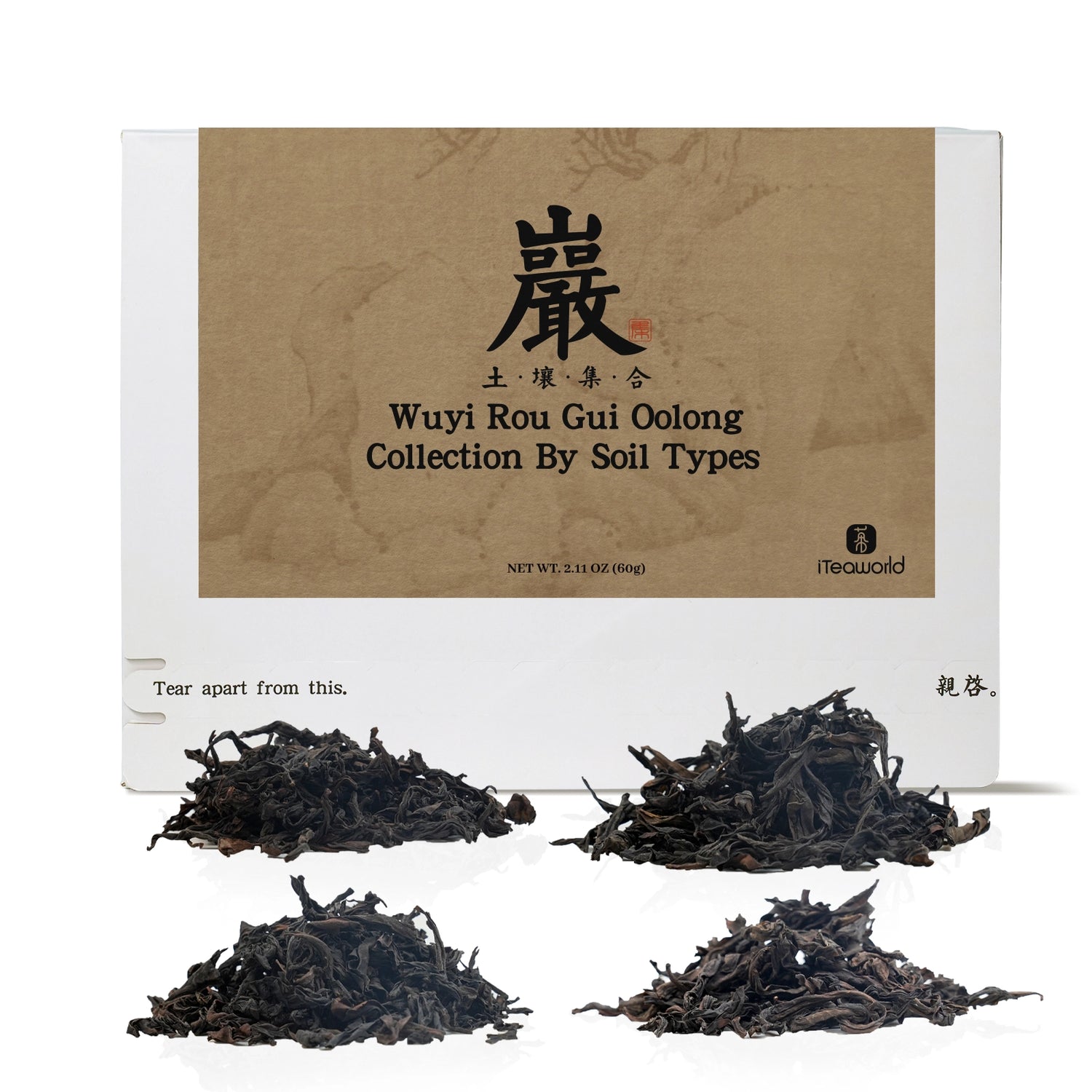

Сравнительный набор улунских чаёв с Уи: 4 типа почвы, 60 г
Сравнительный набор улунских чаёв с Уи: 4 типа почвы, 60 г
Почвенная среда
В «Классике чая» Лу Юя упоминается, что чайные деревья лучше всего растут на разных типах почв: «лучшие растут на гнилых камнях, средние на гравийной почве и худшие на желтой земле». Каменистая почва обеспечивает хороший дренаж и циркуляцию воздуха, предотвращая как заболачивание во время сильных дождей, так и сухость во время засухи. Она богата минералами, и чайные деревья процветают на почве, которая одновременно влажная и кислая. Например, лучшие скальные чаи Уи растут на почве, состоящей из гнилых камней и гравия. С другой стороны, более низкосортные чаи Уи, которые в основном растут на желтой земле, не имеют характерного каменистого привкуса и имеют более простые, менее сложные ароматы и вкусы.
Если вы хотите ощутить, как разные типы почв влияют на вкус улуна, лучшим примером будет коллекция чаёв с утеса Уишань, собранных в разных местах. Сюда входят:
Основной чай Чжэнъянь Уи: известен своей каменистой, щебнистой почвой, представленной знаменитыми Тремя ямами и Двумя ручьями (Сань Кэн Лян Цзянь).
Чай Уи Чжэнъянь: выращивается на почвах, богатых песчано-гравийными породами.
Чай Уи Бан Янь: выращивается на толстых слоях каменистой красной почвы.
Чай Уичжоу: выращивается на почвах с преобладанием лёсса (желтой земли).
В комплект входят:
- Чай Core Zhengyan Wuyi (Core Zheng Yan) 10 г
- Уи Роу Гуй (Чжэн Янь) 10г
- Wuyi Rou Gui (Чай Бан Янь) 20г
- Уи Роу Гуй (Чжоу Ча) 20г
Источник:
- Ядро Чжэн Янь: Уюань Цзянь, деревня Тяньсинь, город Уи, город Уишань, провинция Фуцзянь
- Чжэн Янь: деревня Тяньсинь, город Уи, город Уишань, провинция Фуцзянь
- Чай Бан Янь: деревня Цзиншуй, город Синцунь, город Уишань, провинция Фуцзянь, Китай.
- Чжоу Ча: город Синтянь, город Уишань, провинция Фуцзянь, Китай
Мастер купажа:
- Чэнь Хуэй
Время обработки:
- Октябрь 2024 г.
Срок годности:
- 36 месяцев
Сорт чая:
- Сорта корицы Уи
Высота:
- Ядро Чжэн Янь: 342 метра
- Чжэн Янь: 400-500 метров.
- Чай Бан Ян: около 400 метров
- Чжоу Ча: около 200 метров
Тип почвы:
- Основной материал Чжэн Янь: Гравийный грунт
- Чжэн Янь:песчано-гравийная почва
- Чай Баньян: красная почва с преобладанием толстослойных пород
- Чжоу Ча: желтая почва
Степень окисления : средняя (45-55%)
Степень обжарки:
- Основная часть Чжэн Янь: три обжарки, сильный огонь, 105-110 °C (221-230 °F)
- Чжэн Янь: три обжарки на сильном огне, 105–110 °C (221–230 °F)
- Чай Баньян: три обжарки, сильный огонь, 105-110°C (221-230°F)
- Чжоу Ча: Два обжаривания на среднем огне, около 115°C (239°F)
Метод обжарки (уголь или электричество):
- брикетирование древесного угля
Рекомендации по завариванию:
Заваривание улуна в китайском стиле
Чайная посуда: гайвань или глиняный чайник
Температура воды: 212°F (100°C)
Соотношение чая и воды: 1 г на 0,7 унции (20 мл)
Время заваривания: 15 секунд (1–3 заваривания), затем добавьте 5–10 секунд
Повторное заваривание: до 7 раз
Заваривание улуна в западном стиле
Чайная утварь: чайник, заварник или френч-пресс
Температура воды: 212°F (100°C)
Соотношение чая и воды: 1 ч. л. (2–3 г) на 8 унций (240 мл)
Время заваривания: 3 минуты
Повторное заваривание: 3 раза, каждый раз добавляя по 1 минуте.
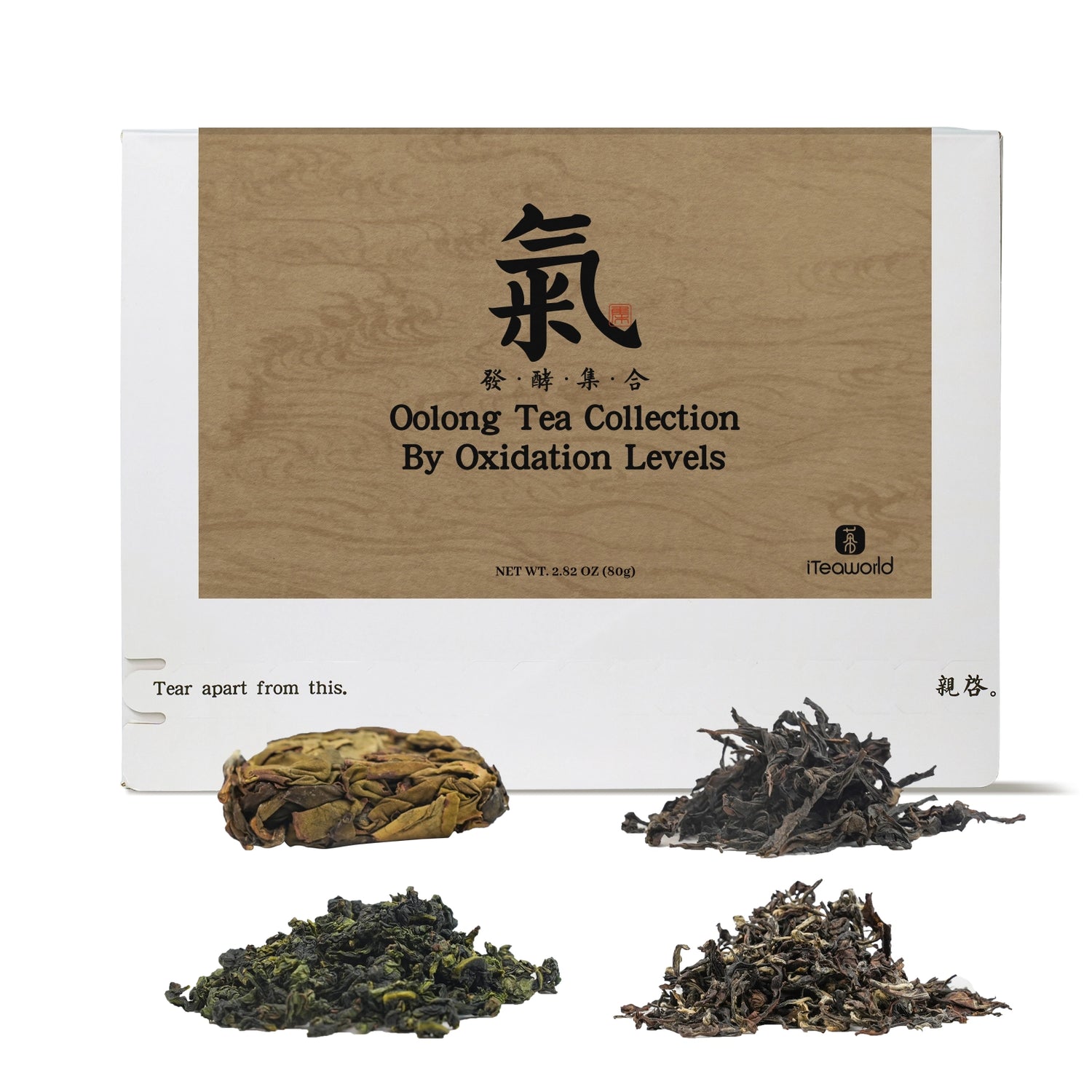
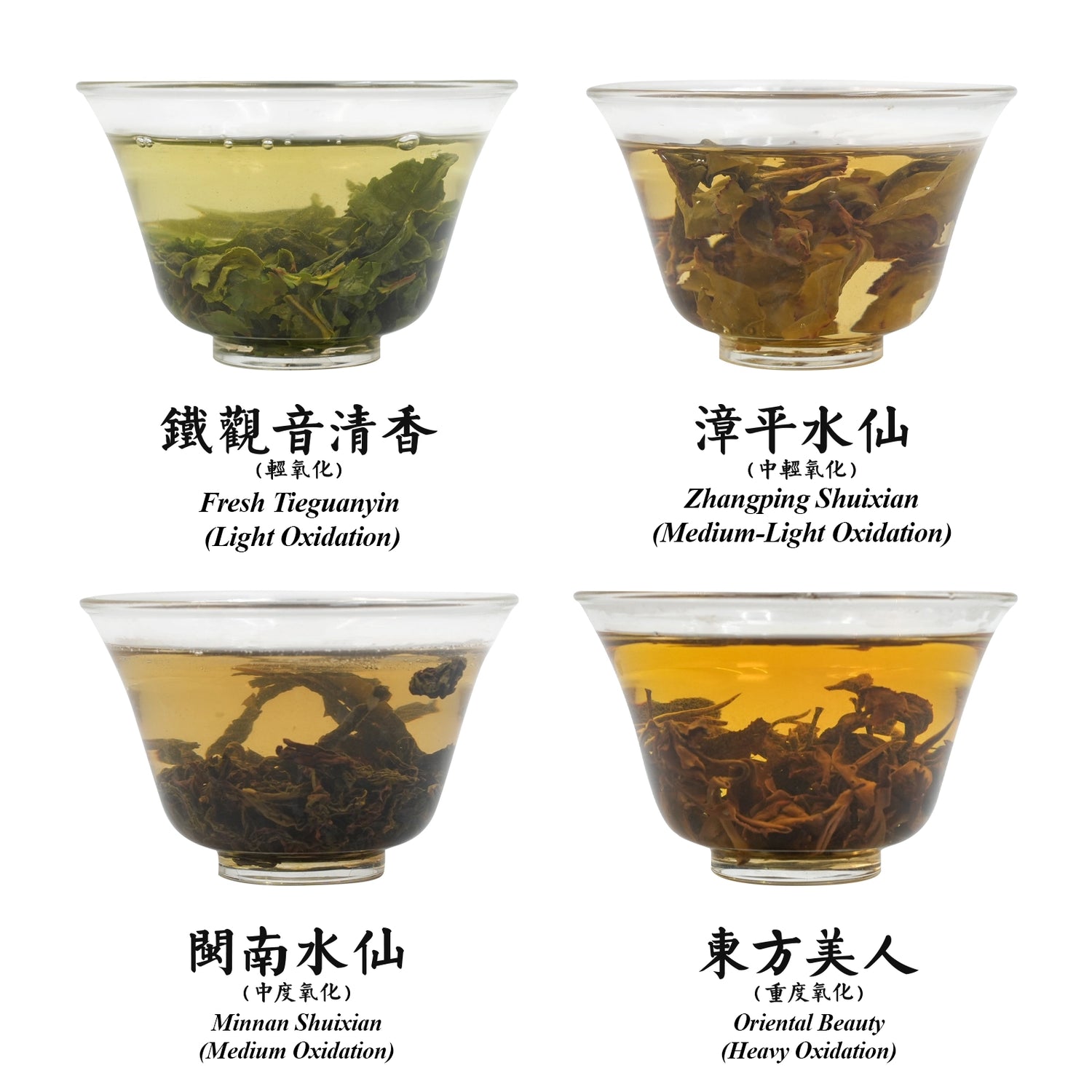
Набор для сравнения чая улун: 4 степени окисления (от Тегуаньинь до Восточной Красавицы), 80 г
Набор для сравнения чая улун: 4 степени окисления (от Тегуаньинь до Восточной Красавицы), 80 г
Чай улун: баланс окисления
Чай улун — это частично окисленный чай, степень окисления которого составляет от 10% до 70%. Окисление играет ключевую роль в формировании аромата чая и яркости его вкуса. Легкое окисление создает свежие цветочные и фруктовые ноты, в то время как более сильное окисление выявляет более насыщенные, зрелые фруктовые или медовые ароматы.
Слабоокисленный улун (10–25 %): такие примеры, как Вэнь Шань Баочжун и слабообжаренный Тегуаньинь, демонстрируют свежие цветочные и фруктовые ароматы.
Умеренно окисленный улун (25–50 %): такие чаи, как Феникс Дань Цун и Тегуаньинь средней обжарки, имеют сбалансированный профиль, сочетающий цветочные ноты с оттенками меда, фруктов или обжарки, что приводит к сложному аромату.
Сильно окисленный улун (50–70 %). Такие классические сорта, как Да Хун Пао, Уи Ругуй и Восточная красавица, обладают ароматами зрелых фруктов, нотками жареного или карамельного вкуса и мягким, насыщенным напитком.
Этот продукт включает четыре известных чая улун, все слегка обжаренные, но с разной степенью окисления. Это идеальный способ изучить, как разные степени окисления влияют на вкус и аромат чая улун.
Включенные продукты:
- Свежий Тегуаньинь (легкое окисление) 20 г
- Чай Чжанпин Шуйсянь Улун (средней легкой степени окисления) 20г
- Миннан Шуйсянь (среднего окисления) 20г
- Oriental Beauty (сильное окисление) 20 г
Источник:
- Свежий Тегуаньинь: деревня Лунцзюань, поселок Лунцзюань, уезд Аньси, провинция Фуцзянь, Китай
- Чжанпин Шуйсянь: деревня Бэйляо, город Наньян, город Чжанпин, провинция Фуцзянь, Китай.
- Миннань Шуйсянь: деревня Уси, город Уфэн, округ Юнчунь, город Цюаньчжоу, провинция Фуцзянь, Китай.
- Восточная красавица: деревня Нэйян, поселок Пиншань, город Саньмин, провинция Фуцзянь, Китай
Мастер купажа :
- Свежий Тегуаньинь: Чэнь Цичжи
- Чжанпин Шуйсянь: Хэ Мэйцин
- Миннан Шуйсянь: Сюй Юнъюань
- Восточная красавица: Ли Цзяньминь
Время обработки:
- Свежий Тегуаньинь: ноябрь 2024 г.
- Чжанпин Шуйсянь: июнь 2024 г.
- Миннан Шуйсянь: декабрь 2024 г.
- Oriental Beauty: начало июня 2024 г.
Срок годности: 24 месяца
Сорт чая:
- Тегуаньинь: разновидности Тегуаньинь
- Чжанпин Шуй Сянь: сорта Миннань Шуйсянь
- Миннан Шуйсянь: сорта Цзяньян Шуй Сиань
- Восточная красавица: сорт Цзинь Сюань
Высота:
- Тегуаньинь: 800-900 метров
- Чжанпин Шуй Сиань: 400-500 метров
- Миннан Шуйсянь: 900-1000 метров.
- Восточная красавица: 1100 метров
Тип почвы:
- Тегуаньинь: красная почва
- Чжанпин Шуй Сянь: желтая и красная почва
- Миннан Шуйсянь: красная почва
- Восточная красавица:Красная почва
Уровень окисления:
- Тегуаньинь: Легкое окисление (10-20%)
- Чжанпин Шуй Сянь: слабое окисление (25-30%)
- Миннан Шуйсянь: Среднее окисление (40-50%)
- Oriental Beauty: Сильное окисление (60-70%)
Степень обжарки:
- Очень легкая обжарка, 70-80°C (158-176°F)
Метод обжарки (уголь или электричество):
- электрическая жарка
Рекомендации по завариванию:
Заваривание улуна в китайском стиле
Чайная утварь: гайвань или глиняный чайник.
Температура воды: 212°F (100°C)
Соотношение чая и воды: 1 г на 0,7 унции (20 мл)
Время заваривания: 10-15 сек (1-3 заваривания), добавить 5-10 сек после
Повторное заваривание: до 7 раз
Заваривание улуна в западном стиле
Чайная утварь: чайник, заварник или френч-пресс.
Температура воды: 90-100°C (194-212°F)
Соотношение чая и воды: 1 ч. л. (2-3 г) на 8 унций (240 мл)
Время заваривания: 3-5 минут
Повторное заваривание: до 3 раз, каждый раз добавляя по 1-2 минуты.
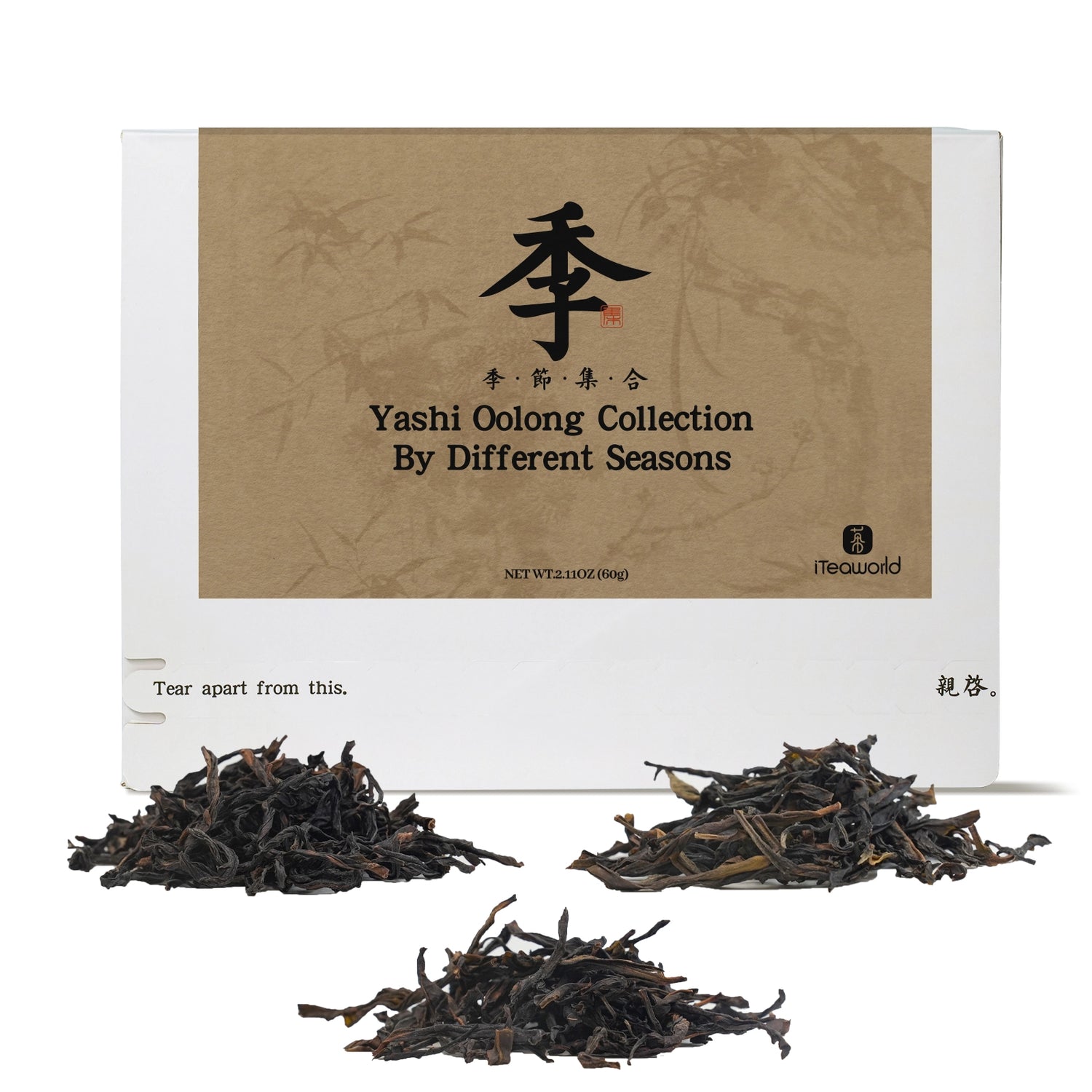
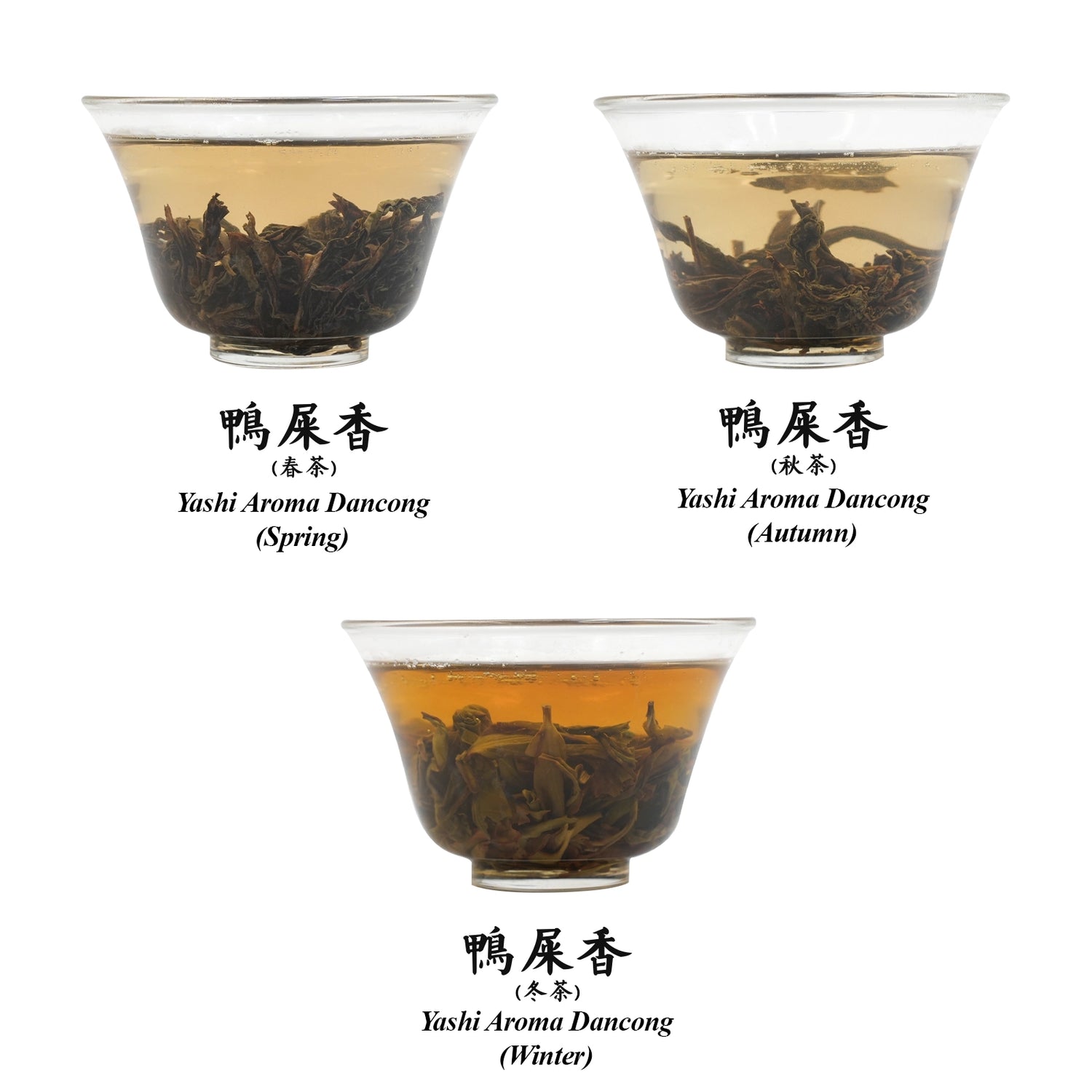
Сравнительный набор улунов Я Ши Сян – весенние, осенние и зимние сорта 60 г
Сравнительный набор улунов Я Ши Сян – весенние, осенние и зимние сорта 60 г
Сезонность чая улун
Улун можно собирать в любое время года: весной, летом, осенью и зимой. Однако уишанский чай собирают только весной. Улун, собранный в полдень, обычно обладает наиболее выраженным ароматом. Летние чаи чаще всего используются для приготовления молочного чая и реже встречаются на рынке листового чая.
Весенние чаи, как правило, растут медленнее, что приводит к повышению уровня аминокислот и полифенолов чая при более низком соотношении фенолов к аминокислотам. Однако из-за частой дождливой погоды в таких регионах, как Фуцзянь и Гуандун, весенние чаи могут содержать меньше ароматических соединений, чем осенние или зимние. Поэтому осенние и зимние улуны, как правило, обладают более выраженным ароматом. Зимние улуны, в частности, могут иметь даже свежий, прохладный аромат. Весенние улуны, напротив, обычно богаче веществами, что обеспечивает более сладкий и свежий вкус.
Этот продукт включает три разных сезонных чая с ароматом утиного помёта от одного и того же чайного мастера из деревни Хутоу города Фэнхуан. Степень ферментации и обжарки у каждого чая разная, так как улун адаптируется к условиям, в которых растут листья. Зимние листья тоньше, поэтому ферментация и обжарка обычно менее интенсивны. Попробуйте эти три чая, чтобы почувствовать разницу во вкусе в зависимости от сезона.
В комплект входят:
- Я Ши Сян (Утиное дерьмо) Дан Цун Улун (Весенний) 20г
- Я Ши Сян (Утиное дерьмо) Дан Цун Улун (Осень) 20г
- Я Ши Сян (Утиное дерьмо) Дан Цун Улун (Зимний) 20г
Происхождение: деревня Хутоу, город Фэнхуан, район Чаоань, город Чаочжоу, провинция Гуандун, Китай.
Мастер купажа: Линь Шупэн
Время обработки: 20 ноября 2024 г.
Срок годности: 36 месяцев
Сорт чая: Я Ши Сян (Утиное дерьмо) сорт Дэн Конг
Высота: 300-400 метров
Тип почвы: желтая почва
Степень окисления: средняя (40-50%)
Степень обжарки:
- Весна: две обжарки на среднем огне, около 100 °C (212 °F)
- Осень: две обжарки на среднем огне, около 100°C (212°F)
- Зима: одна обжарка, слабый огонь, около 80°C (176°F) Очень слабая обжарка, 70-80°C (158-176°F)
Метод обжарки (уголь или электричество): брикетирование древесного угля
Рекомендации по завариванию:
Заваривание улуна в китайском стиле
- Чайная посуда: гайвань или глиняный чайник
- Температура воды: 212°F (100°C)
- Соотношение чая и воды: 1 г на 0,7 унции (20 мл)
- Время заваривания: 15 секунд (1–3 заваривания), затем добавьте 5–10 секунд
- Повторное заваривание: до 7 раз
Заваривание улуна в западном стиле
- Чайная утварь: чайник, заварник или френч-пресс
- Температура воды: 212°F (100°C)
- Соотношение чая и воды: 1 ч. л. (2–3 г) на 8 унций (240 мл)
- Время заваривания: 3–5 минут
- Повторное заваривание: до 3 раз, каждый раз добавляя по 1 минуте.
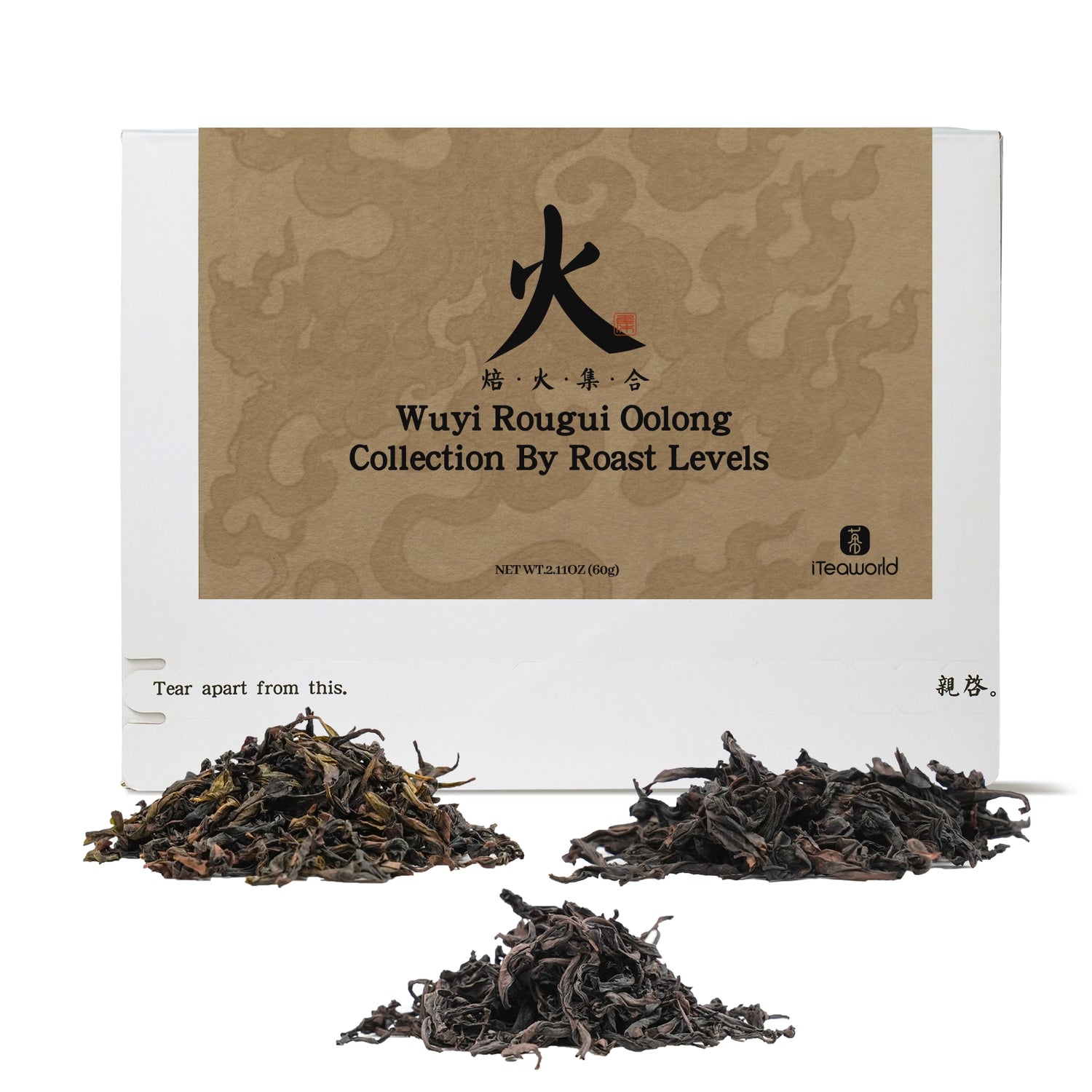
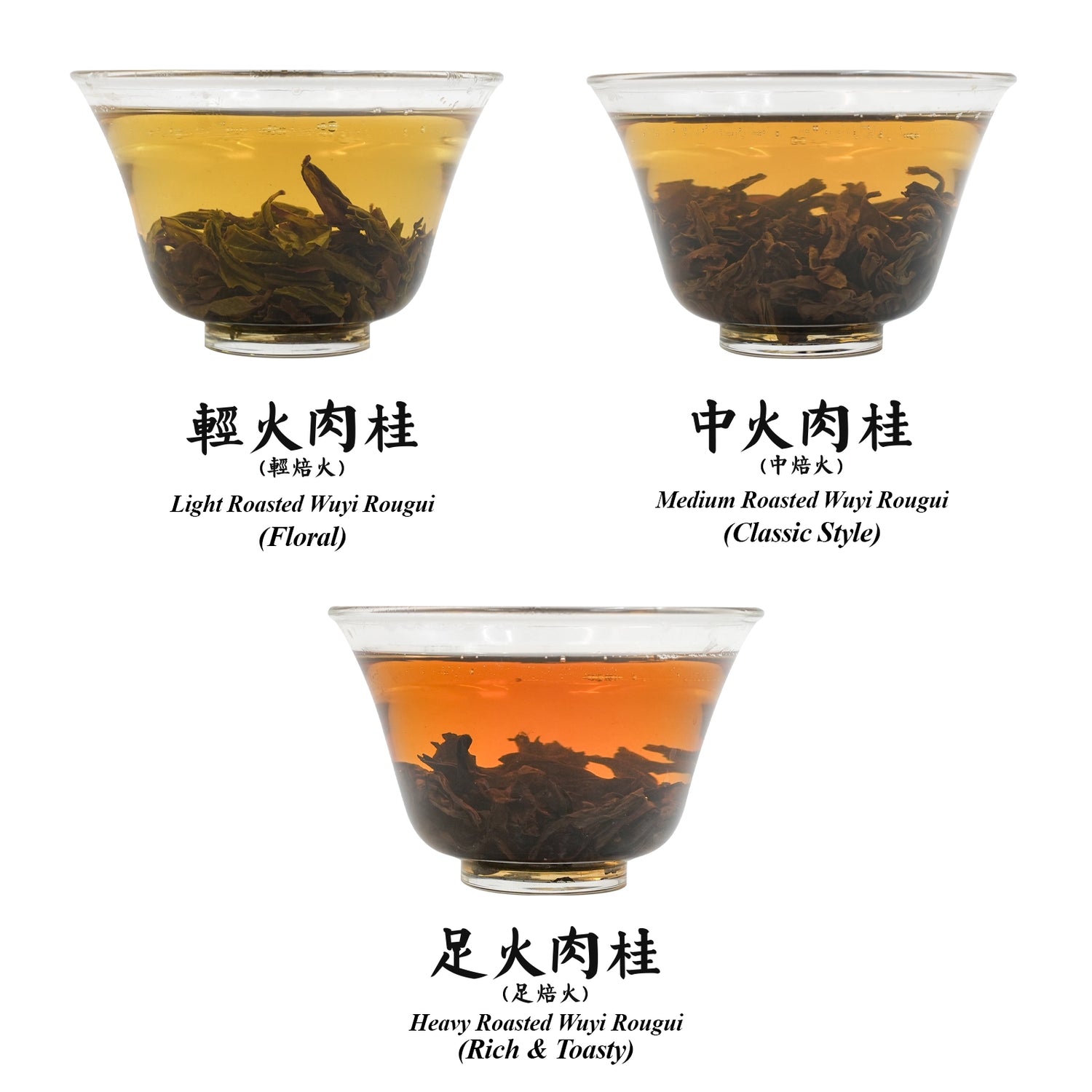
Набор для сравнения Уишаньского улуна: 3 уровня обжарки (от слабого до сильного), 60 г
Набор для сравнения Уишаньского улуна: 3 уровня обжарки (от слабого до сильного), 60 г
Искусство обжарки чая улун
Обжарка улуна преследует три основные цели: снижение влажности, удаление посторонних привкусов и снижение содержания кофеина, при этом усиливая аромат и вкус чая. Чаи с разной степенью окисления требуют разной степени обжарки. Обычно слабоокисленные чаи слегка обжаривают для усиления их вкуса. Если чай слегка окислился, но сильно обжарился, он может иметь слишком дымный привкус, часто из-за того, что окисление было проведено неправильно, а обжарка используется для его маскировки.
Степень обжарки существенно влияет на аромат и вкус чая. Легкая обжарка сохраняет свежий цветочный аромат, в то время как сильная обжарка создает более насыщенный, мягкий напиток с поджаренными или дымными оттенками.
Этот чай содержит улун Wuyi Rougui из знаменитых гор Уи в провинции Фуцзянь, созданный тем же мастером чая. Единственное отличие заключается в уровне обжарки, что дает вам прекрасную возможность изучить, как обжарка формирует вкусы чая улун.
Происхождение: деревня Цзиншуй, город Синцунь, город Уишань, провинция Фуцзянь, Китай.
Мастер купажа : Чэнь Хуэй
Время обработки: ноябрь 2024 г.
Срок годности: 24 месяца
Сорт чая: Уишаньский коричный
Высота: около 400 метров
Тип почвы: гравийная почва
Степень окисления: Окисление 45-55%
Уровень обжарки: одинарная обжарка: легкая обжарка, 90–100 °C (194–212 °F)
Тройная обжарка: средняя обжарка, 105–115 °C (221–239 °F)
Тройная обжарка (полный огонь): сильная обжарка, 120–130 °C (248–266 °F)
Метод обжарки (уголь или электричество):
Светлая корица: электрическая обжарка 20 г
Корица средней интенсивности: брикетирование древесного угля 20 г
Full Flame Cinnamon: брикетированный древесный уголь 20 г
Рекомендации по завариванию:
Заваривание улуна в китайском стиле
Чайная утварь: гайвань или глиняный чайник.
Температура воды: 212°F (100°C)
Соотношение чая и воды: 1 г на 0,7 унции (20 мл)
Время заваривания: 10-15 сек (1-3 заваривания), добавить 5-10 сек после
Повторное заваривание: до 7 раз
Заваривание улуна в западном стиле
Чайная утварь: чайник, заварник или френч-пресс.
Температура воды: 190-200°F (88-93°C)
Соотношение чая и воды: 1 ч. л. (2-3 г) на 8 унций (240 мл)
Время заваривания: 3-5 минут
Повторное заваривание: до 3 раз, каждый раз добавляя по 1-2 минуты.
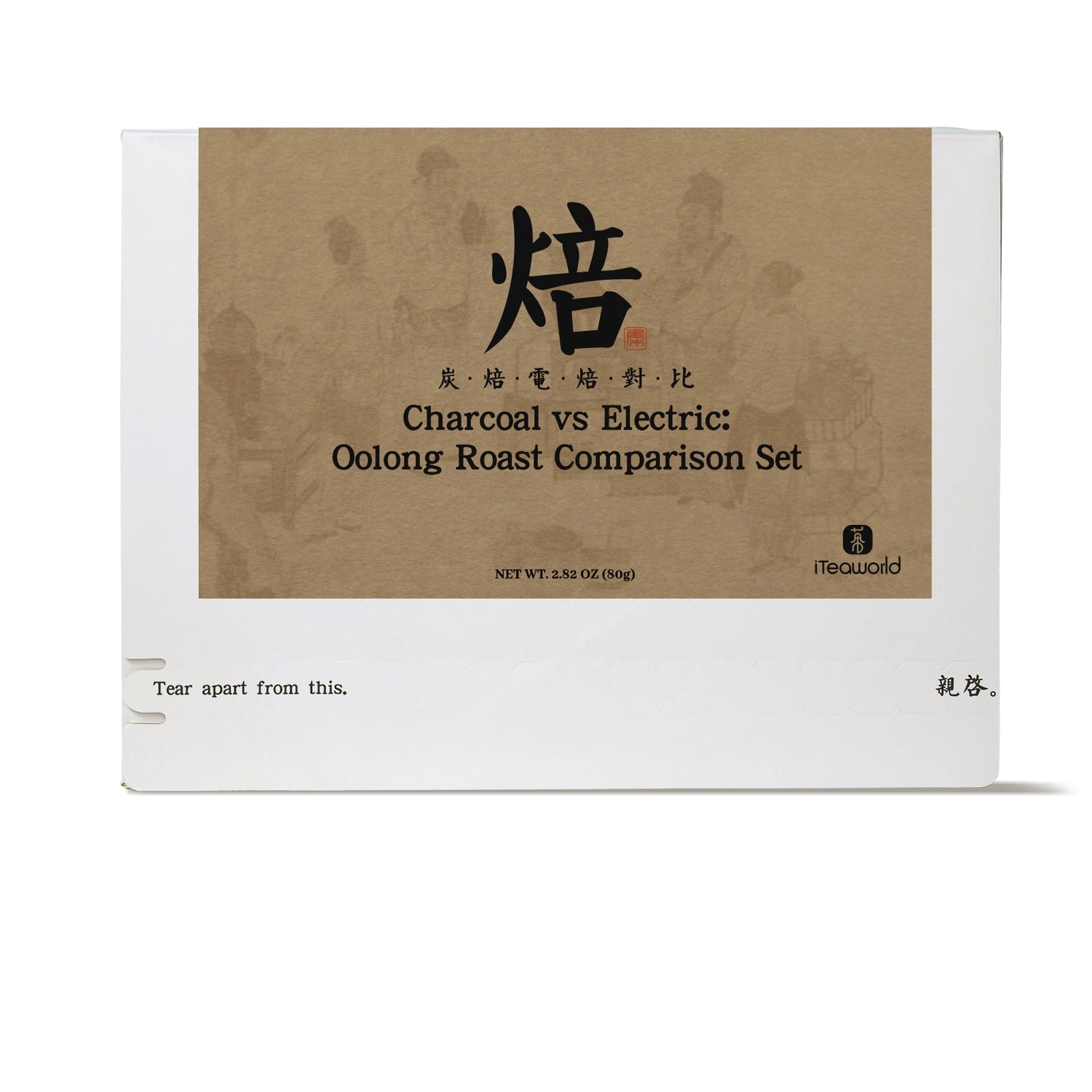
Набор для сравнения обжарки улуна: угольная и электрическая, 80 г, предпродажа
Набор для сравнения обжарки улуна: угольная и электрическая, 80 г, предпродажа
Этот продукт находится в стадии предварительной продажи и, как ожидается, поступит в продажу в августе.
Пожалуйста, обратите внимание перед оформлением заказа.
Путешествие огня и технологий
«Веками китайские мастера улуна спорили: медленный танец угля или точность электрического нагрева? Этот набор предлагает вам исследовать две философии обжарки на примере чая Phoenix Dancong и Wuyi Rock — одна из них основана на мудрости предков, другая усовершенствована технологиями».
Состав продукта:
Уи Ругуи, обжаренные на углях* 20 г
Электрическая жарка Уи Руги* 20 г
Жареный на углях Ми Лан Сян Даньцун* 20 г
Electric-Roasted Mi Lan Xiang Dancong* 20 г
Информация о продукте (Уи Ругуй)
Тип: Полукамень (Бань Янь)
Происхождение: деревня Цзиншуй, город Синцунь, город Уишань, провинция Фуцзянь, Китай.
Высота: 400 м
Продюсер: Чэнь Хуэй
Сроки обработки: Маоча: апрель 2024 г.; Первичная обжарка: август 2024 г.; Окончательная обжарка: ноябрь 2024 г.
Информация о продукте (Ми Лан Сян Даньцун)
Происхождение: деревня Фэнси, город Фэнхуан, город Чаочжоу, провинция Гуандун, Китай.
Высота: 600–800 м
Возраст дерева: ~30 лет
Продюсер: Линь Чжицян
Сроки обработки: Маоча: апрель 2024 г.; Первичная обжарка: август 2024 г.; Окончательная обжарка: ноябрь 2024 г.
Обжарка на древесном угле: искусство традиционного улуна
Обжарка на древесном угле — это душа традиционного улуна. Медленная, слабая обжарка на древесном огне, например, на лонгане или личи, преображает листья, создавая насыщенный вкусовой профиль с карамельной сладостью, минеральными нотками и дымной глубиной.
Этот метод идеально подходит для чая Wuyi Rock и Phoenix Dancong, поскольку он превращает травянистые ноты в мягкие, сложные профили и подчеркивает карамельную и фруктовую сладость.
По сравнению с современной электрической обжаркой обжарка на древесном угле обеспечивает:
Лучшая текстура — глянцевые темно-коричневые листья вместо зеленовато-коричневых
Более насыщенные ароматы — дымные и натуральные ароматы чая вместо одного жареного вкуса
Больше заварок — более 8 вместо 5
Более длительный срок хранения — продукт сохраняется более 5 лет, в отличие от продукта, который нужно употребить в течение года.
Несмотря на такие проблемы, как высокие выбросы углерода, обжарка на углях необходима для элитных улунов, подобно тому, как дубовые бочки нужны для изысканного вина. Она превращает чай из «свежих листьев» в живое, развивающееся искусство.
Электрическая обжарка: современный подход к улунскому чаю
Электрическая обжарка — ключевой метод современного производства улуна, обеспечивающий значительные преимущества в эффективности и стабильности качества. С помощью электрических нагревательных элементов температура точно контролируется в диапазоне от 70 до 130 °C, а время обжарки обычно составляет от 2 до 5 часов. Этот процесс повышает скорость производства по сравнению с традиционной обжаркой на древесном угле.
Одной из отличительных особенностей электрической обжарки является цифровая регулировка температуры, поддерживающая её в пределах ±5 °C. Это устраняет неравномерные колебания температуры, характерные для обжарки на древесном угле, что делает её идеальным решением для улунов лёгкой ферментации, сохраняющих свежие цветочные и фруктовые ароматы.
Чай, обжаренный на электрической сковороде, обладает яркими цветочными нотками и освежающим вкусом. Цвет чая прозрачный и яркий. Хотя ему не хватает насыщенного вкуса чая, обжаренного на древесном угле, он отвечает требованиям современных потребителей к лёгкому, освежающему чаю.
Как заваривать?
Чайная посуда: исинский чайник (предпочтительно из глины чжуни) или толстостенная гайвань.
Качество воды: родниковая или мягкая вода (жесткость < 50 мг/л)
Соотношение чая и воды: 5 г чая / 100 мл воды
Температура воды: 100°C (кипящая)
Промывание: быстро промыть кипящей водой (менее 5 секунд); вылить первую настойку.
Время заваривания:
Инфузии 1–3: по 15 секунд каждая
Настои 4–10: Ми Лань Сян: увеличивать на 5 секунд на каждый настой
Уи Ругуй: увеличивайте время на 5–10 секунд на каждую заварку
Recently viewed products
Chat with fellow tea lovers, ask questions, and share your tea moments.





